Just added to your cart
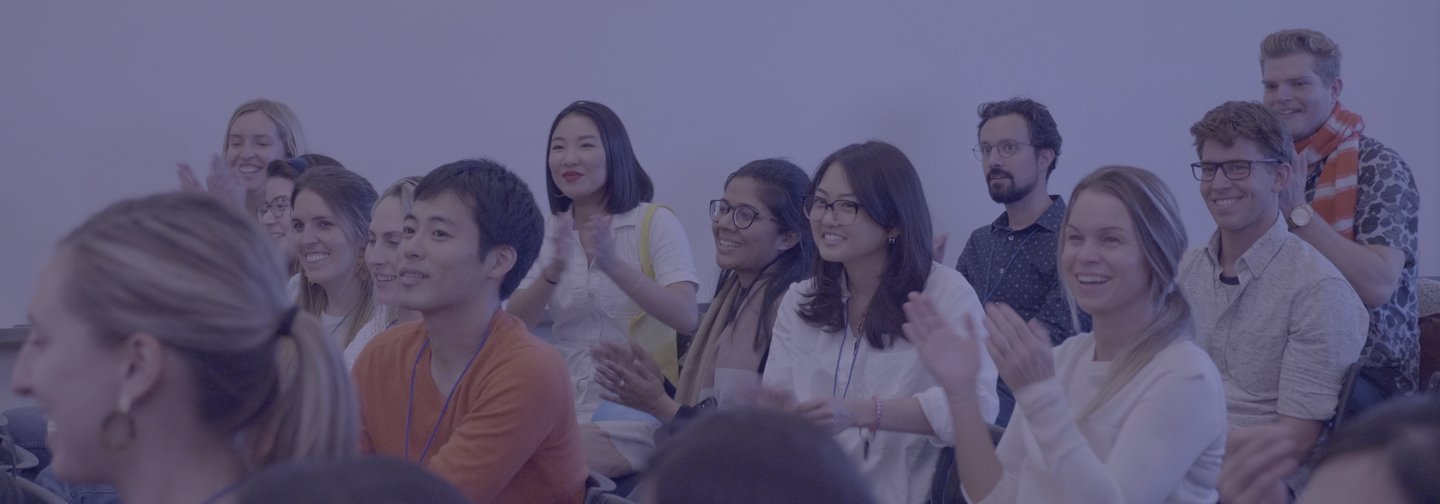

Impactful Presentations
Why do presentations often fail to have the impact we desire? One reason is that information alone will never move people. In this course, you’ll go beyond presenting just the facts and figures to craft compelling presentations that will motivate others, inspire action, and enable buy-in. By surfacing what matters to your audience, you’ll learn to create presentations that are both meaningful and memorable. Gain the confidence and skills it takes to shift the way people think, feel, and behave.
Note: While this course is not focused on the visual design of presentations, it does cover a few quick tips to get you started.
Course Outcomes
- Deliver presentations that spark a shift in beliefs, behaviors, and mindsets.
- Sequence and convey your information in a way that will create a meaningful journey for your audience.
- Open hearts and minds by developing a trusted relationship with your audience.
- Apply techniques to help people pay attention and remember the information you share.
- Practice with unique presentation methods in order to create an engaging experience for your audience.
Part of Certificate Programs
- Communicating for Impact Certificate
- Collaborative Leadership Certificate
Skills You’ll Gain
Adding product to your cart
Go Deeper with Certificate Programs
Impactful Presentations is part of two certificate programs:
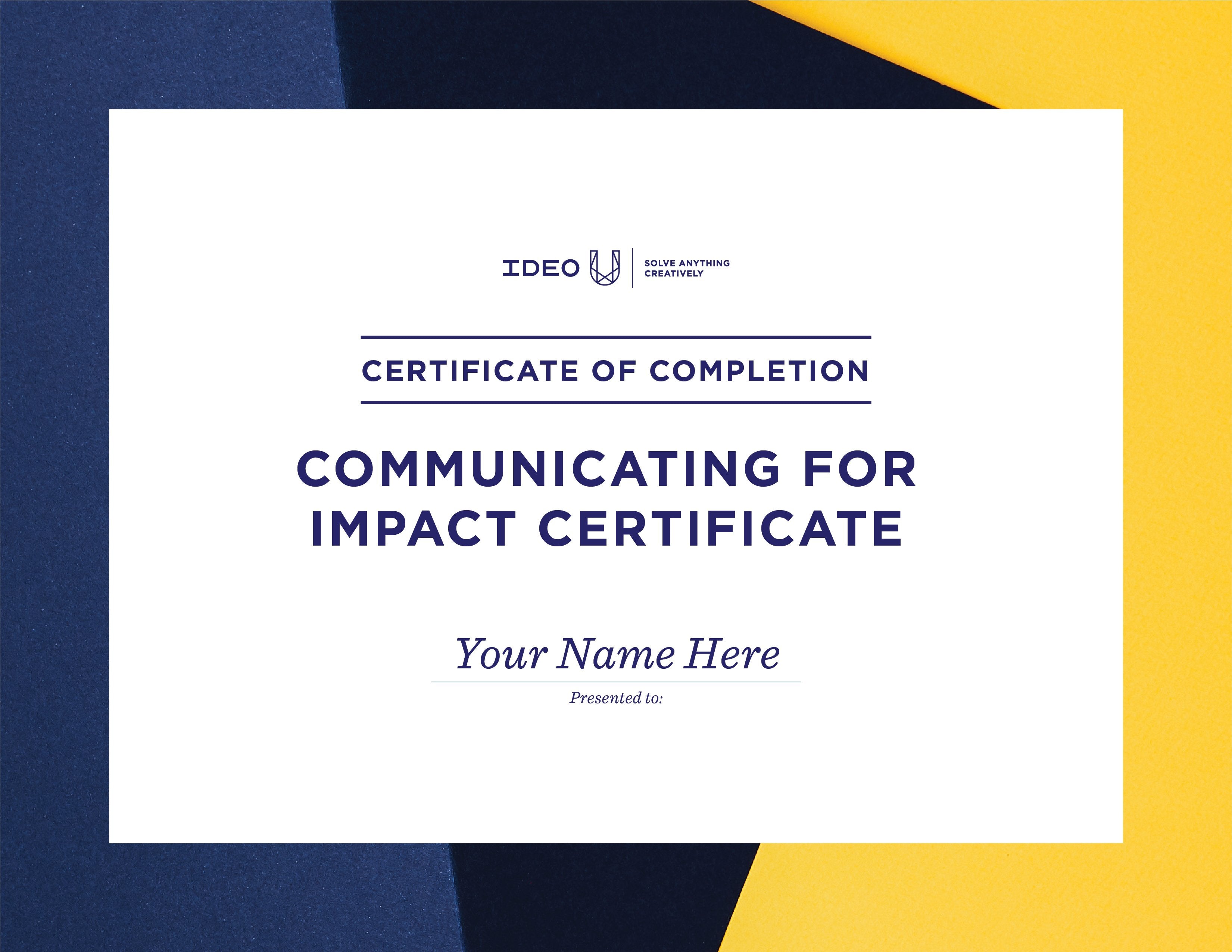
What You'll Learn
Week 1: introduction - move your audience, 2 video lessons.
- Messages That Spark Change—It’s not what you say, but how you say it
- Mentor Moment—Try something new
1 Assignment
Choose Your Presentation—Choose the 10-15 minute presentation you’ll be workshopping throughout the course. Use an existing presentation or choose from one of our sample presentation prompts. Identify your audience, your starting assumptions for what you must do or include in this presentation, and the skills you most want to grow.
Note: For course assignments, you’ll need access to either Google Slides or Microsoft PowerPoint. There will be multiple opportunities to get feedback on your drafts along the way, though you are not required to give your presentation live to the class.
Week 2: Plan the Journey
4 video lessons.
- What’s the Point?—Identify the goal of your presentation
- It’s Not About You—Empathize with your audience
- Shape Your Story—Build emotional appeal and interest
- Mentor Moment—Start with emotion
Crafting Story Arcs—Identify the beats, or key moments, of your presentation. Build four potential sequences to determine the strongest organization of your content. Use your learnings from this exercise to iterate your Big Idea and the shift you want the audience to make.
Week 3: Become the Guide
3 video lessons.
- Create a Connection—Bridge the divide between you and the audience
- Establish Your Credibility—Inspire trust and belief
- Keep It Human—Present as your authentic self
Design for Connection, Credibility, and Authenticity—Select different methods for building a connection, establishing credibility, and presenting authentically, and brainstorm how you might bring them to life. Think through the details of implementing these methods by experimenting.
Week 4: Make it Memorable
- Best Intentions; Bad Presentations—Avoid common presentation mistakes
- Make Patterns—Encourage understanding and retention
- Break Patterns—Shake things up to capture their attention
- Mentor Moment—Find the medium that fits your message
2 Assignments
Create Pattern Breaks—Brainstorm ways to break patterns using physical space, the senses, and audience interactivity. Build experiments to further explore your ideas.
Build a Storyboard—Use the feedback and insights from the first three assignments to create a storyboard for your presentation. Identify opportunities to engage, or re-engage, the audience, and consider the holistic journey through your content. Start a visual mood board to guide design decisions.
Week 5: Conclusion - Look Ahead
- Bringing It All Together—A Presentation Case Study
- Mentor Moment—Encouragement to explore
- The End Is The Beginning—Evolve your story and yourself
Presentation Finale—Design a meaningful ending and evolve the structure and flow of your presentation using insights from the feedback you’ve received. Craft a full second draft, diving more deeply into visual decisions and scripting key moments. Reflect on your experience over these five weeks to understand the skills and techniques you’ve gained and areas to continue growing.
Meet Your Instructors
Former Director of Health & Well-Being at IDEO
Ann is a design researcher with roots in anthropology and journalism. Prior to IDEO, she made documentaries for public television. Filmmaking taught her how to visually tell stories as well as how to find, edit, and shape them. At IDEO, she does the same thing, taking the raw materials—interviews, data, observations—and crafting them into stories that inspire.

Ann is a design researcher with roots in anthropology and journalism. Her portfolio spans the design of HIV prevention products, digital tools to help kids build emotional strength, and the re-design of the US digital immigration experience. Prior to IDEO, she worked for over a decade as a filmmaker and journalist; her latest documentary, “Lovesick,” is about matchmaking for HIV+ singles in India. Filmmaking taught her how to visually tell stories as well as how to find, edit, and shape them. At IDEO, she does the same thing, taking the raw materials—interviews, data, observations—and crafting them into stories that inspire.
From 2016 to 2017, she served as the Chief Design Officer for U.S. Surgeon General Vivek Murthy. Ann holds a joint degree in Anthropology and the Study of Religion from Harvard College. She’s a board member of Noora Health and the Karen Schmeer Film Editing Fellowship, and a past fellow of the Sundance Institute. Ann is an avid traveler, with the Okavango Delta and Tibet among her favorite spots, and an obsessive photographer.
Alex Gallafent
Senior design director at ideo.
Alex is a designer, theater artist, and journalist. Throughout his career, Alex has been figuring out the things audiences need and how best to bring them to life. He’s presented stories on theater stages in London and New York, in broadcast journalism for the BBC, and across the world with IDEO.

Alex currently leads the New York wing of IDEO’s Design for Food studio. He’s worked with major clients in hospitality, media, government, financial services, and beyond. He’s also taught design thinking, storytelling, and research at New York University, The School of Visual Arts, and The New School. A former correspondent for US public radio and the BBC World Service, he’s a past Fellow at the International Reporting Project at Johns Hopkins. Alex studied philosophy at Oxford University and trained in classical acting at LAMDA. He’s performed Shakespeare in Tokyo and written music for plays in London’s West End. In New York, Alex performs improv, plays drums for the city's only improvised rock'n'roll storytelling band, and hosts as many dinner parties as possible.
Frequently Asked Questions
How do ideo u cohort courses work does my time zone matter.
We offer three types of courses: self-paced courses, cohort courses, and certificate programs. Cohort courses run on a set calendar, with fixed start and end dates. Course learning is self-paced within those dates and requires approximately 4-5 hours per week over 5 weeks. Courses consist of videos, activities, assignments, access to course teaching teams, and feedback from a global community of learners. There are also optional 1-hour video Community Conversations, held weekly by the teaching team.
All of our cohort courses are fully online, so you can take them from any time zone, anywhere in the world. With our cohort course experience , while you'll be learning alongside other learners, you'll still have the flexibility to work at the pace that fits your own schedule. There aren’t mandatory live components, so you don't have to worry about having to log in at a specific time. At the same time, you'll have access to a teaching team, which is composed of experts in the field who are there to provide you feedback, and there are also plenty of options to connect with your fellow learners.
What is the role of the instructor and teaching team? Will learners be able to get feedback?
Course instructors have a strong presence in the courses through the course videos, but they're not actively providing feedback or holding direct conversations with our learners. We have a teaching team to ensure that you have the feedback, guidance, and support you need to learn successfully in your course. Our teaching team members are design practitioners that have experience applying course methods and mindsets in a wide variety of contexts around the world.
Our teaching team consists of teaching leads and teaching assistants, who are experts in their fields. Many of them have been with IDEO U for many years, and we have selected those who have direct experience with applying the course methods and mindsets in all sorts of contexts around the world. They all go through multiple training sessions by our instructional designers on not only on the subject matter, but also on how to create safe and collaborative learning experiences and environments.
What are Community Conversations, and how are they related to the course material?
Community Conversations are one-hour live video conversations hosted by the teaching team on Zoom. These happen once per week, with each one having two to three time options to accommodate different time zones. Each week focuses on the lesson that you’ve just gone through, so the output and the content depend on the specific lessons. You'll have the opportunity if you work together with your peers on the tools and mindsets from the course, reflect on what you’ve learned, and also address any challenges that you might be going through.
What will I have access to during and after my course?
All course materials, including videos, activities, and assignments will be available while you are enrolled in a course. During the 5 weeks of the course, you will have full access to our learning platform and can refer back to it any time. You will only have access to the course materials while you are enrolled.
Assignments must be submitted during the 5-week course duration in order for you to receive a certificate of completion.
Can I take the course with my team?
Absolutely! We have had many teams go through our courses together. For those taking our courses as a team, we provide a number of additional benefits:
1. A Team Learning Guide, developed to provide your team with resources to facilitate offline discussions that complement the in-course experience.
2. A Manage Learners function, which provides visibility into your team's progress within the course.
3. The ability to create a private Learning Circle, which is a closed space for discussion on the learning platform specifically for your team.
For more information, visit our Team Learning page.
Do you offer discounts?
We offer a discount when you enroll in multiple courses at the same time through some of our certificate programs, including Foundations in Design Thinking , Business Innovation , Human-Centered Strategy , and Communicating for Impact .
You can also enter your email address at the bottom of this page in order to receive updates on future offers or possible discounts.
Will I get a certificate after completing a course?
After completing a cohort course, you will be able to add it to your “licenses and certifications” on LinkedIn.
We also have certificate programs that consist of multiple courses. After completing a certificate, you will receive a certificate of completion via email as a downloadable PDF within 1-2 weeks of completing the final required course. Certificates are configured for uploading and sharing on LinkedIn.
How do I purchase a cohort course?
You can purchase a course on our website using a credit card, PayPal, or Shop Pay. For US customers, we also offer installment plans at checkout if you use the Shop Pay method of payment.
We typically are not able to accommodate bank transfer or invoicing. However, if your order includes 10 seats or more, please contact [email protected] and our team will be happy to review your request.
Collaborate with a Global Community
Work with expert coaches.
Our teaching team has extensive applied industry knowledge. They'll help deepen your understanding and application of the course content by facilitating written discussions, live video moments, and assignment feedback.
Expand Your Network
Join virtual live discussion groups for deeper conversation, reflection, and connection led by teaching team members and available multiple times a week across time zones.
Receive Feedback
Gain tips, techniques, and a downloadable feedback guide; and share and receive feedback on assignments from peers.
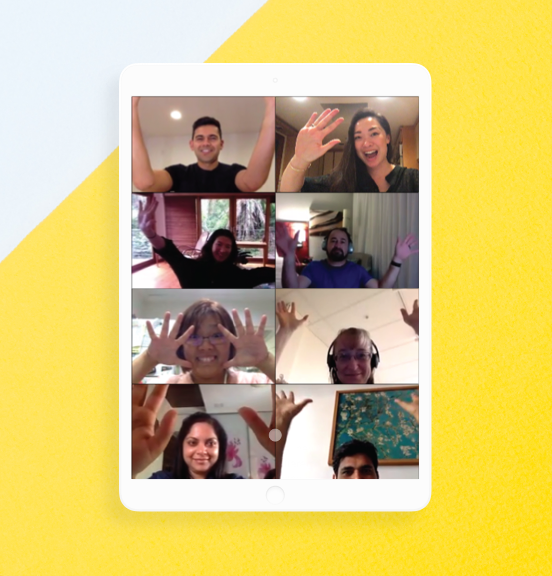
What Others Are Saying
“I've been delivering presentations my whole career, this course is game-changing for everything I knew. This course made me realize there are more creative ways to deliver a message.”
“I had an aha moment when I realized that you need to focus on the shift you want your audience to make versus the content you want to say.”
“Wonderful course on key elements that anyone should use to have a more memorable presentation prepared!”
“Having spent my career presenting to varied audiences, there is no doubt that most presentations are too data-heavy and the audience is lost early on. There is no one better than IDEO colleagues Ann and Alex to provide novel and impactful skills to those who present for a living….or for anyone who just wants to get better at presentation. Not only will you learn great new skills, but you will have fun doing so!”
Learners Also Purchased
Storytelling for Influence

Leading for Creativity

Cultivating Creative Collaboration

Enroll As a Team
The practice and application of design thinking, innovation, and creativity is highly collaborative and team based—which is why we believe that learning is better together. Take a course as a team and develop new skills and mindsets, have deeper discussion during course kickoff and debrief sessions, and build a shared understanding.
Want to learn more about Impactful Presentations?
- Please complete this required field.
- choosing a selection results in a full page refresh
- press the space key then arrow keys to make a selection
Cart Preview
If this box is checked, you will be able to enter name and email of the recipient(s) after your purchase is complete.

You are creative
Get tips on building creative confidence and applying the skills of design thinking.
Awesome, you're in!
Get the Syllabus
Enter your email to receive the Impactful Presentations syllabus and email communications from IDEO U.
The syllabus should be in your inbox shortly. Click below to view the syllabus now.

- Live Virtually
Executive Presentation Training Programs

Master the Art of Exceptional Presentations
For decades, Speakeasy has been at the forefront of transforming leaders into captivating speakers. Our executive presentation training programs are meticulously crafted to give professionals the tools they need to create compelling narratives, design powerful presentations, and deliver them with unmatched conviction.
With a focus on storytelling techniques, impactful slide design, executive presence , and assertive delivery, we bring out the unique speaker in every leader. We go beyond just technique – we help you find your voice, and ensure it resonates in any boardroom.
Increased confidence among presenters when using a well-designed slide - TechSmith
More persuasiveness for presentations paired with visual aids over those without. - Management Information Systems Research Center
of employed Americans believe presentation skills are critical for workplace success. - Prezi
Flexible Program Options for Any Schedule
At Speakeasy, we understand that life is filled with diverse commitments and schedules can vary greatly. That’s why we offer a comprehensive array of programs to accommodate every professional’s unique circumstances. Whether you prefer the traditional in-person classroom experience, the convenience of live online virtual sessions, or the autonomy of self-administered digital courses, we have the perfect fit for you.

What to Expect From Executive Presentation Training
A commanding presentation can be the defining factor in clinching deals, influencing stakeholders, and propelling your career forward. Here are five compelling reasons to invest in executive presentation training:
- Enhanced Presentation Skills: Our training polishes your ability to design striking slides, narrate compelling stories, and deliver with a clear, confident voice.
- Masterful Storytelling: Learn the techniques to weave stories that engage, captivate, and drive your message home.
- Robust Audience Engagement: Grasp how to read and respond to your audience, ensuring active participation and lasting impact.
- Strategic Slide Design: Make every slide count. Learn the art of creating visual aids that complement and amplify your message.
- Preparedness for Varied Scenarios : Be it boardrooms, webinars, or international
Let Us Match You With An Executive Presentation Training Program
Hear success stories.
Discover the Speakeasy Difference
At Speakeasy Inc., we’re dedicated to helping high-potential professionals rediscover the art of conversation, create lasting connections, and elevate their personal communication style. In today’s fast-paced digital world, authentic, face-to-face communication is more important than ever before. Here’s why you should choose Speakeasy:

Expertise in Communication
Our team of experienced coaches are passionate about communication and its power to transform lives. We bring together the latest research and time-tested techniques to help you become a confident, engaging, and influential communicator in any situation.

Personalized Approach
We understand that each individual has unique strengths and areas for improvement when it comes to communication. That’s why our programs are tailored to your specific needs, ensuring that you receive the guidance and support necessary to achieve your personal and professional goals.

Interactive Learning Environment
We believe that the best way to learn is by doing. Our immersive workshops and one-on-one coaching sessions provide ample opportunities for you to practice and refine your communication skills in a supportive, feedback-driven environment.
FAQs About Speakeasy Executive Presentation Training Programs
What exactly is covered in the executive presentation training, how does speakeasy's approach stand out from the crowd, who is the ideal candidate for this training, what key skills can i expect to develop through this training, how is the training delivered are there virtual options available, start speaking the language of success today.
Ready to transform your organization’s communication skills and drive business success? Connect with us below and let our expert coaches help you chart the path to exceptional communication with our tailored executive coaching programs.
- Name (First & Last) *
- Company Name *
- Business Title *
- Mobile Number
- Email Address *
- What is the best way to contact you? Select Text Phone Call Email Message in a bottle
- How did you hear about us? * Select Internet Search Recommendation Business Forum Social Media Online Advertisement Other Advertisement Other Let us know how we can help you! If you are here from a referral please include who referred you in your message as well. We looking forward to working with you on your communication journey!
- SUGGESTED TOPICS
- The Magazine
- Newsletters
- Managing Yourself
- Managing Teams
- Work-life Balance
- The Big Idea
- Data & Visuals
- Reading Lists
- Case Selections
- HBR Learning
- Topic Feeds
- Account Settings
- Email Preferences
What It Takes to Give a Great Presentation
- Carmine Gallo

Five tips to set yourself apart.
Never underestimate the power of great communication. It can help you land the job of your dreams, attract investors to back your idea, or elevate your stature within your organization. But while there are plenty of good speakers in the world, you can set yourself apart out by being the person who can deliver something great over and over. Here are a few tips for business professionals who want to move from being good speakers to great ones: be concise (the fewer words, the better); never use bullet points (photos and images paired together are more memorable); don’t underestimate the power of your voice (raise and lower it for emphasis); give your audience something extra (unexpected moments will grab their attention); rehearse (the best speakers are the best because they practice — a lot).
I was sitting across the table from a Silicon Valley CEO who had pioneered a technology that touches many of our lives — the flash memory that stores data on smartphones, digital cameras, and computers. He was a frequent guest on CNBC and had been delivering business presentations for at least 20 years before we met. And yet, the CEO wanted to sharpen his public speaking skills.
- Carmine Gallo is a Harvard University instructor, keynote speaker, and author of 10 books translated into 40 languages. Gallo is the author of The Bezos Blueprint: Communication Secrets of the World’s Greatest Salesman (St. Martin’s Press).
Partner Center
Home Blog Education How to Create and Deliver Training Presentations That Make an Impact
How to Create and Deliver Training Presentations That Make an Impact
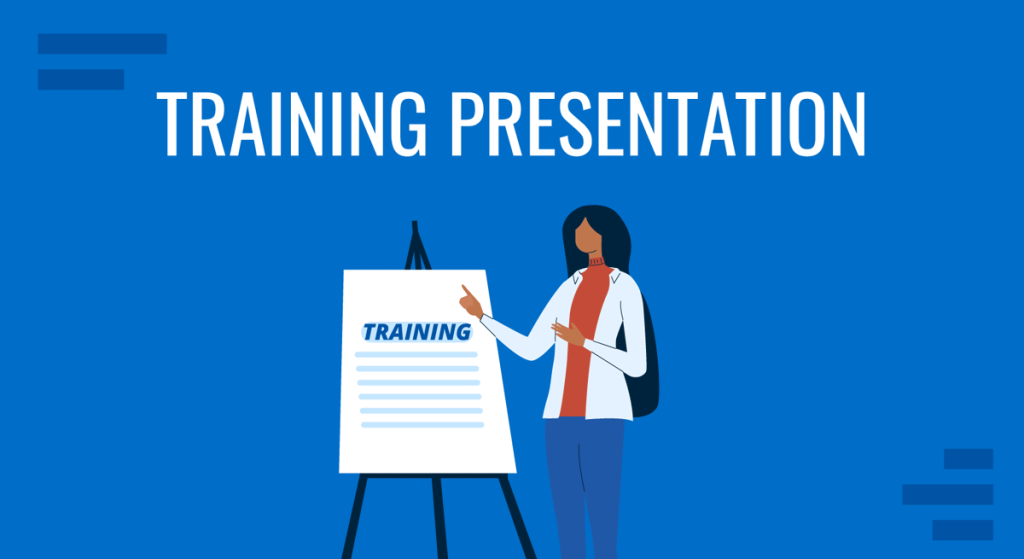
Blended learning and hybrid workplaces have improved how employees train and optimize their work output. Corporate training is now a rich combination of in-person group sessions, live online lessons, and SCORM courses that employees can follow at their own pace.
Are your training presentations up to the challenge?
Learning & Development strategists, HR, and performance management managers take note. In this guide, we’ll show you how to create a training deck from start to finish . Plus, some template examples and optimization tips for creating training presentations that make learning more effective.
What is a Training Presentation?
A training presentation is a set of slides created to teach a skill or increase knowledge of a topic. They’re used in training and development strategies in companies worldwide. Across the slides in a training presentation, employees learn essential information and skills to do their jobs better and grow in their careers.
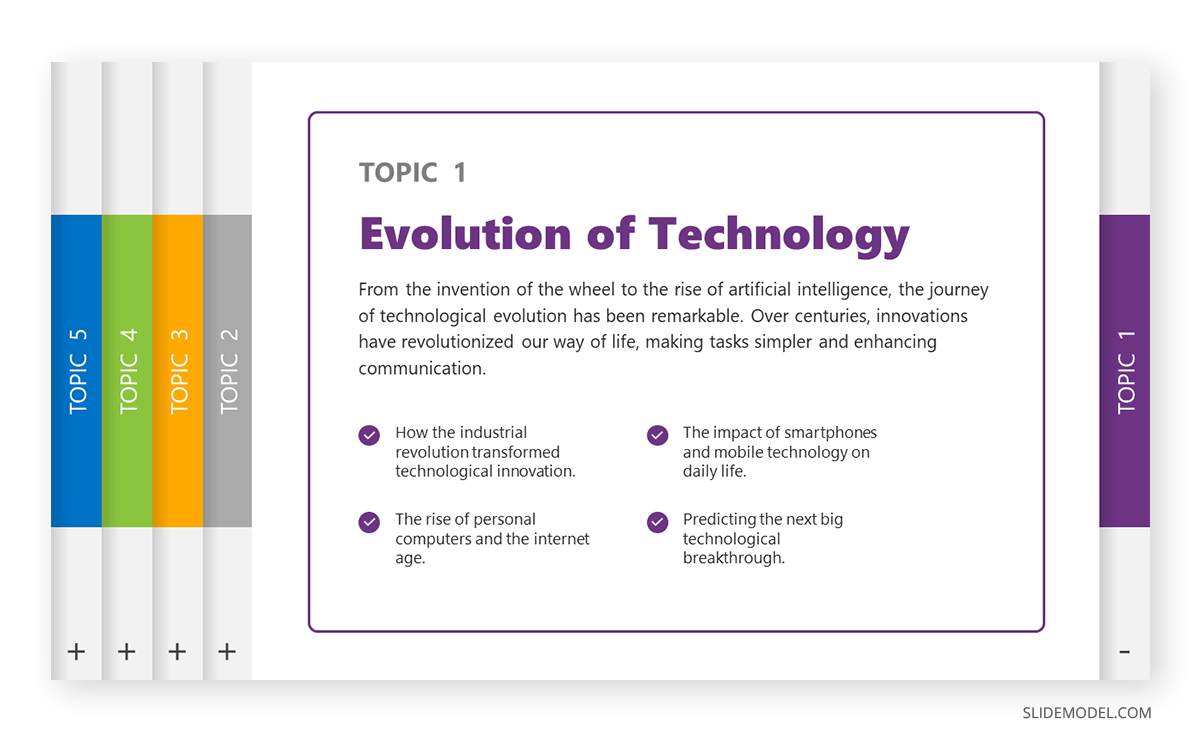
Types of Training Presentations
Training presentations form part of all L&D initiatives in an HR department. They have one of two purposes; to train employees for the job at the present moment and to train them for growth and the future.
Training for the job instructs employees on how to carry out their assigned tasks and responsibilities . The skills they learn follow guidelines from the company’s brand, processes, and structure.
Examples include:
- On-the-job training
- Practice simulations
- Orientation
- Skillbuilding

To train for growth , employees are given resources to increase their capabilities, like learning new technology or methodology. They learn skills that will help their career future, preparing them for a promotion within the company or for changing teams laterally in a new role.
Growth training includes topics like:
- Soft skills
- New technology
- New processes or methodologies
- Job rotation
- Personal development
- Career expansion

Why Are Training Presentations Important?
High-quality training and development initiatives in a corporate setting offer many benefits. Three of the most relevant are employee buy-in and retention, company culture, and professional development.
Employee Buy-in and Retention
When training presentations are achieved at a high standard, team members in People Management, Human Resources, Learning & Development, and DEI feel confident and proud of their work in training fellow employees.
They accompany employees along training paths, so it’s better if they’re invested in what they’re sharing. For a solid brand identity —and clear company culture—thorough training helps with buy-in straight out of the gate with an onboarding strategy. Then continues with regular training initiatives that lead to retention, satisfaction and loyalty.
Company Culture
The role of company culture in an organization has a lot of weight towards brand equity. But a strong culture doesn’t happen overnight; it’s instilled in the employees’ minds through team-building activities, motivational seminars, and equitable training in all aspects of work.
Company culture flows through the ongoing interaction between trainers and trainees. Group sessions and training days help build relationships between teams and employees. Feeling invested is a trait developed through the right type of training.
Professional Development
High-quality training for professional development is essential in every organization. On-the-job training for daily tasks is only part of the puzzle; employees also need to train for growth.
In-company training for professional development includes training for higher—or lateral—positions. Offering training for the future not only heightens professional development for individual employees but also carves a strong culture.
How to Create a Training Presentation
Let’s create a training deck together. We’ll use a case study to guide us along.
You and your L&D team at an IT Company are preparing a company-wide training session about the SCRUM framework before implementing it in more aspects of the business. The Training presentation is titled “Understanding the SCRUM Framework. Agilizing our productivity, together.” Sessions will be blended/hybrid to accommodate both in-office and remote employees. There will be a camera recording the instructor, and remote employees will see the presentation and the video of the instructor talking side by side on their screen.
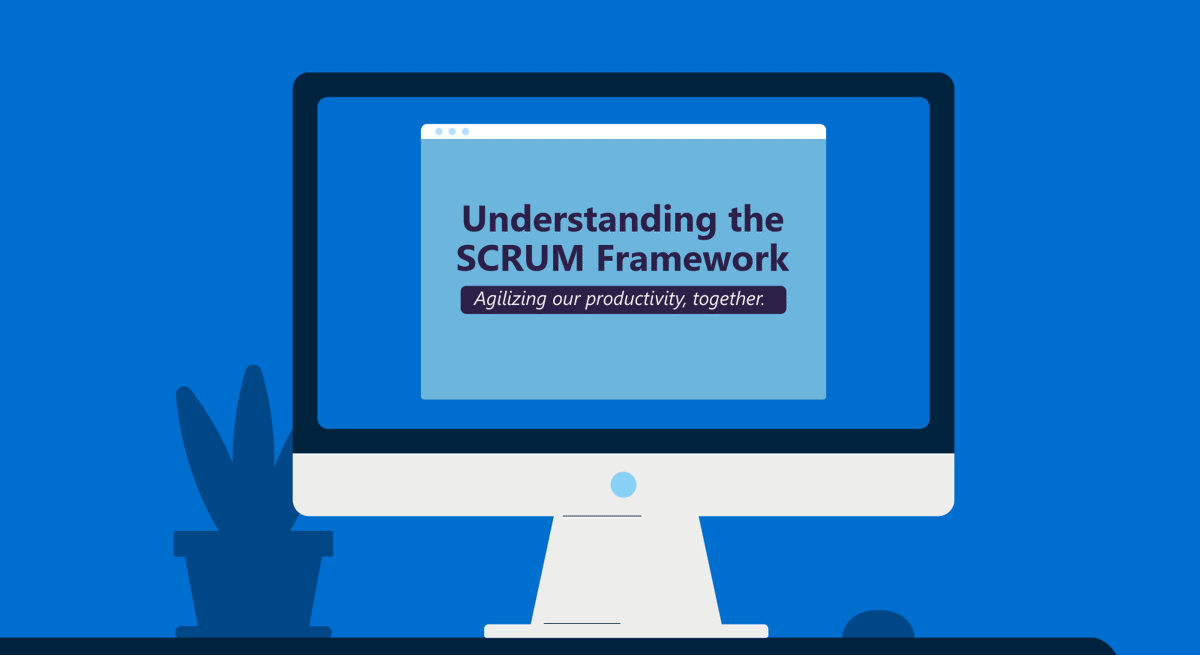
1. Plan and prepare
Planning and strategizing are as important in training as in other business areas. Your training presentation already has a purpose, company-wide training about the SCRUM framework. But if you aren’t sure what employees need to learn to increase productivity and employee satisfaction, you’ll have to do some research.
Figuring out your people’s learning and development needs takes some work. Are you using a performance management system? What does the reporting reveal? Where are employees failing to set goals? How can training presentations help?
Analyze the reports, and you’ll see where they’re lacking. Plan upskilling strategies around those topics. With a clear objective, start preparing the training, presentation, and conversation points for group sessions.
Put together a lesson plan covering the main characteristics of your presentation. Use it as a foundational reference during the production of the training presentation slides .
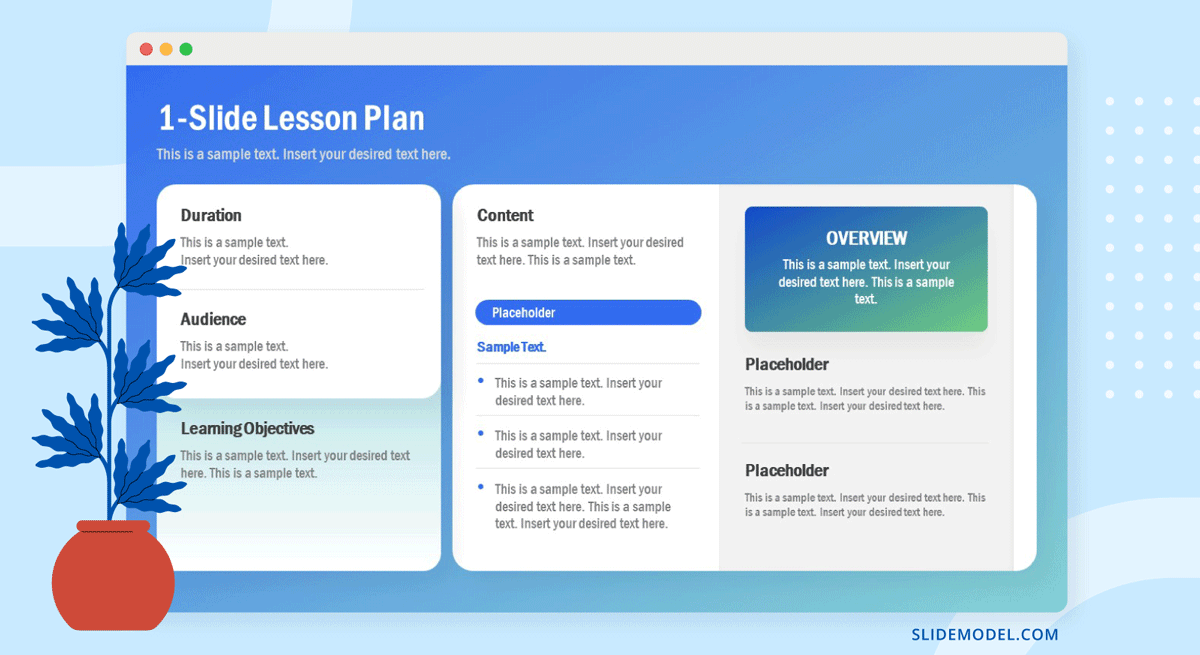
2. Create a basic structure
Creating a structure for a training presentation is a critical step before designing slides or even writing the content. Training presentations with a set structure are more impactful than ones without.
Following a structure makes the transference of knowledge much simpler. Write an outline that follows that structure. Do it on a document or use a visual tool like a storyboard to overview the full presentation deck .
The main structure for any training presentation has three parts; beginning, middle, and end. Yes, it’s that simple.
- Start with an agenda slide that covers the contents of the training presentation and builds a framework of what to expect out of this training program. Follow by listing the syllabus for the course and required learning material that will be accessible, and where students should download/access such content.
- Inform learners that at the end of the presentation, they will have all the basic and practical knowledge to understand and begin working with a SCRUM framework.
- Explain (if necessary) what they need as a prerequisite to get the most out of the training.
- Any instructions they need to follow during the session, such as how to approach practical exercises or instructions for deliverables expected.
- Share all supplemental material through links they can download or access from. This should also include any book chapter mentioned, video resources, photos, etc. Cloud-based storage accessible from the Company’s intranet tends to suit all needs.
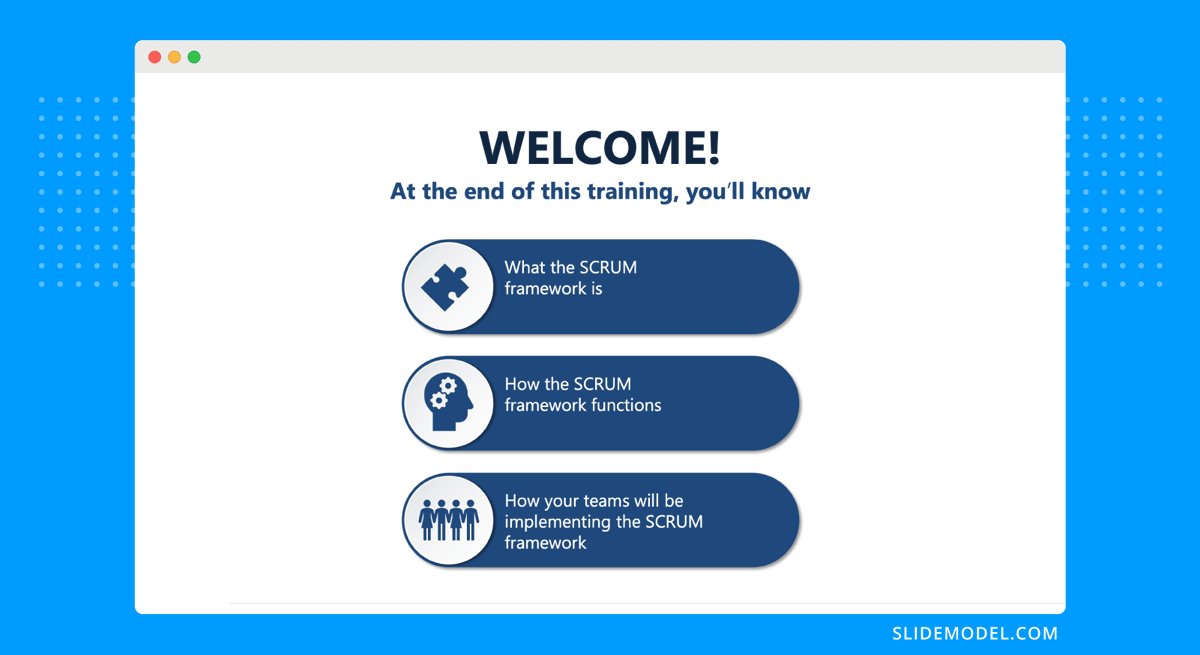
- Throughout the meatiest slides of the presentation, teach them about the SCRUM framework. Then share how their team will use it to agile production and work in general.
- Use visual training techniques to explain themes and topics clearly.
- Create interactive moments for learners to imprint information.
- Incorporate a variety of teaching formats to cover all learning styles; video, text, images, infographics, interactive activities, etc.
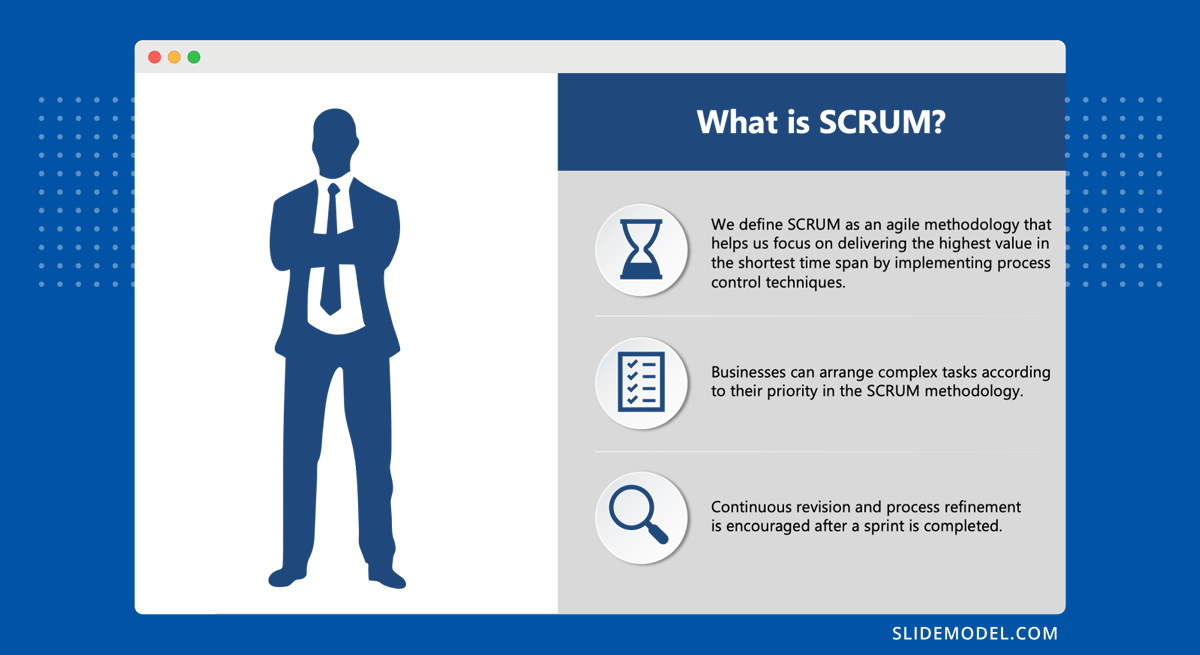
- Craft a few slides summarizing what they learned using a highlights list.
- Have learners take a quiz to test their knowledge and offer results that include the right answers to the questions they got wrong.
- Share references to supplemental material where learners can get more information on the topic.
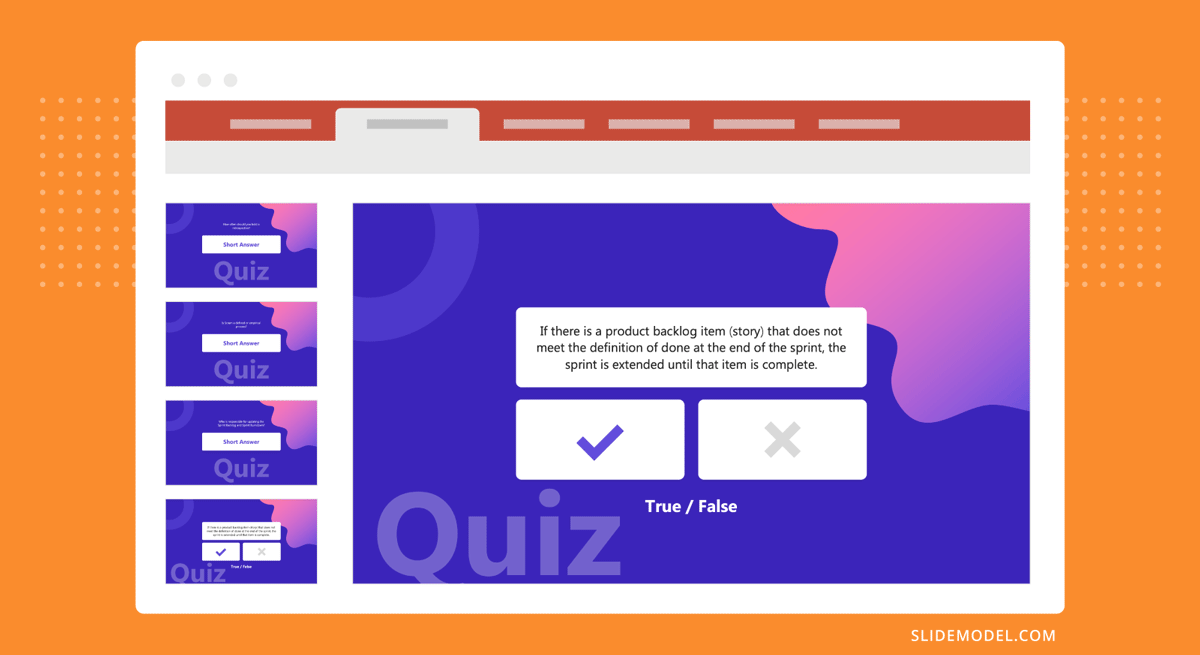
The Middle Structure
In the middle is where most of the magic happens. A training presentation is much like a lecture in its purpose. Therefore, using teaching and lecture techniques in your presentations can only be a good idea.
Here are six lecture structures that you can apply to the middle of your presentation. For the SCRUM Framework training, we’ll use the first example .
- Start with what students can be expected to know to what students don’t know.
- Proceed from reality to abstract ideas, theories, and principles.
- Begin with generalizations and continue with particular examples and applications.
- Open with simple ideas and round them up with complex ones
- Start sharing common misconceptions and then explain the truth.
- Go from a whole view to a detailed view.
3. Gather resources
Organize all the content you’ll need for the presentation in a folder on the cloud or your team’s content library. Browse the SlideModel template collection, where you’ll find plenty of slides, full decks, and cut & copy elements to include in your training deck. For the slides to describe the SCRUM framework, we used this 3D PPT template of how the parts of the framework are interconnected.
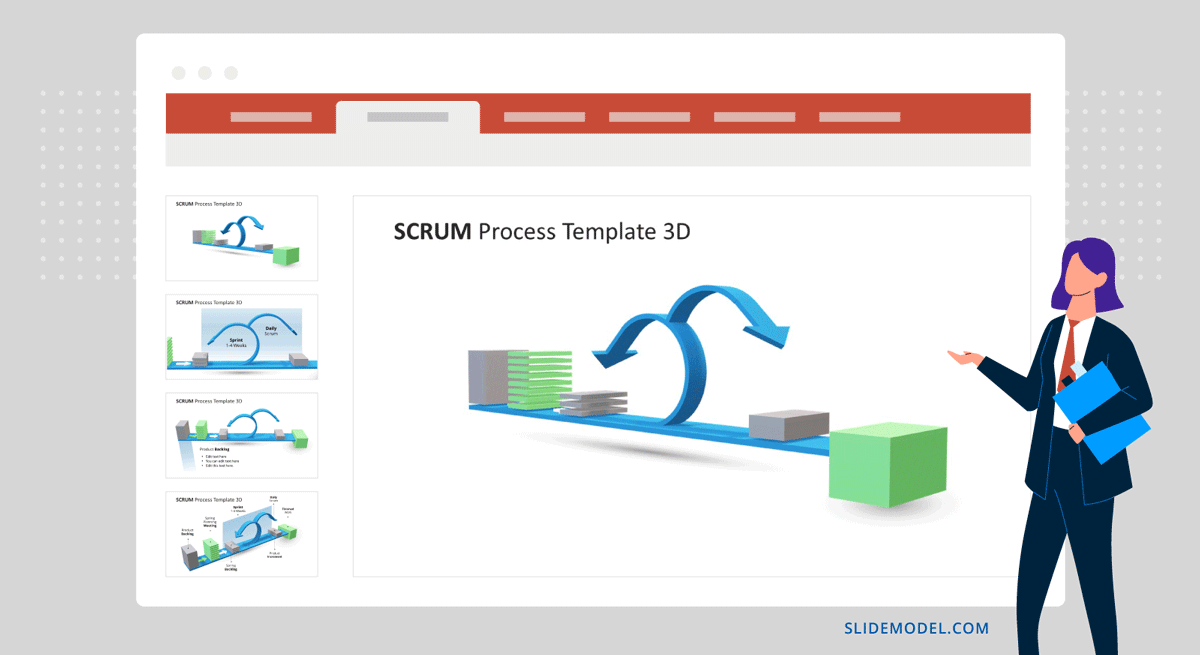
Resource checklist for any training presentation:
- All visuals, videos, and PowerPoint slides add value to the training.
- Case studies and examples support your points.
- Your company has the appropriate licenses to use the resources that are included in the final design.
- All references, citations and attributions are gathered for inclusion in the training documentation.
- Your templates are from Slidemodel.
4. Design the slides
Now, it’s time to put it all together and design the slides. Get all your resources ready, a list of all the templates you’ll use, and start a new project on PowerPoint.
Have your outline and/or storyboard open and start designing slides. Start with the cover and then follow the structure you decided on. Work your way through to the end and add a quiz. Here are some instructional presentation design best practices to help you along.
- Create visual unity and balance by choosing a color theme and font pairing that supports the brand message and purpose of the training.
- Mind the flow between slides from beginning to end. Use subtle transitions that don’t distract from the learning.
- Use a table of contents, section dividers, and interactive slide menus for easier navigation.
- Ensure each slide has a focal point and a visual hierarchy between all other elements.
All training material emulates the company brand, its values and vision. As marketing material follows visual and messaging brand guidelines, so should internal development content.
Rather than mix & match slide templates, you can try a really fast method to create an entire training presentation by stating its topic, checking the suggested content, and selecting the desired slide design. This is possible thanks to the SlideModel’s AI Presentation Maker .
5 Training Presentation Slide Examples
Are you looking for inspiration to create a training presentation? SlideModel has numerous designs suitable for explaining, visually dissecting, and analyzing the material. Likewise, you’ll find templates that help L&D strategists communicate with instructors during the planning phase and beyond.
Here are five templates that can help with your training presentation design.
Employee Onboarding
First, this multi-slide ppt template for training is an employee onboarding presentation . Use it to cover all characteristics of a corporate onboarding process. Slides include;
- Pre-boarding
- Training Activities
- Onboarding Roadmap
- Title & closing slides
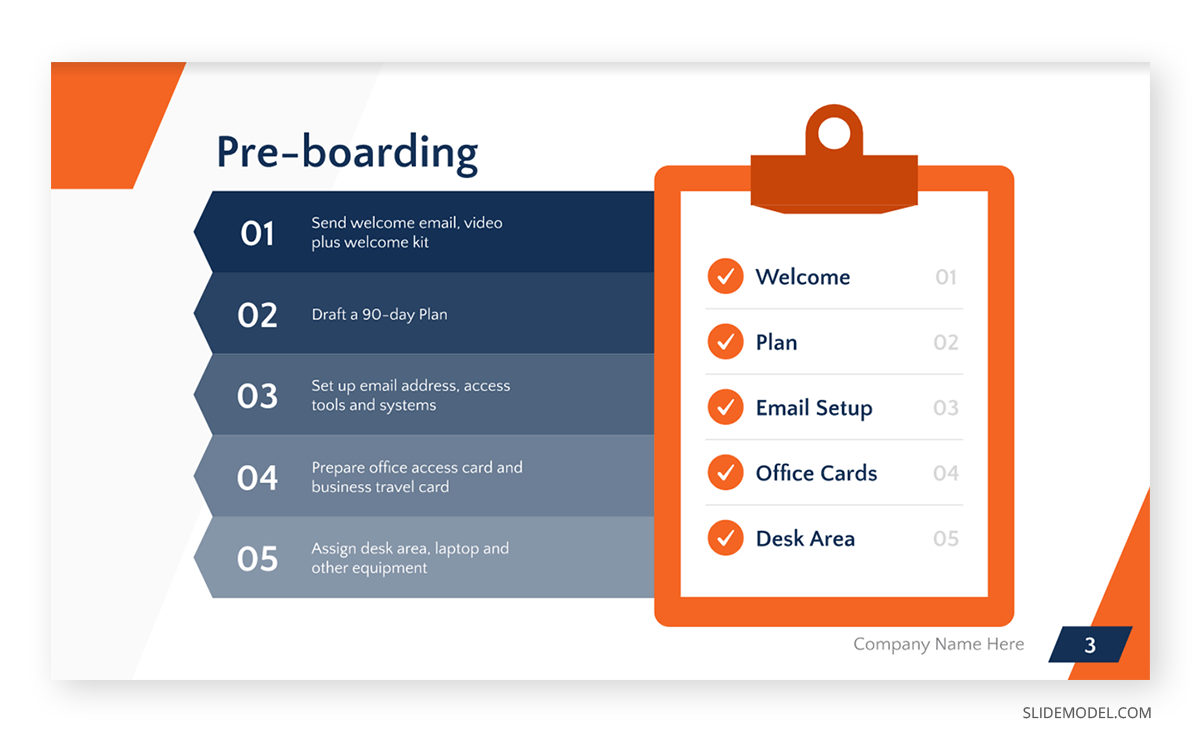
Managerial Grid
The Blake & Mouton managerial grid is a great way to explain and analyze the different types of management based on production concerns and people concerns. Production concerns are characterized by tasks, and people are concerned with relationships.
Matrix Grids can be used for other purposes as well. Like stakeholder engagement , talent analysis , and content marketing.
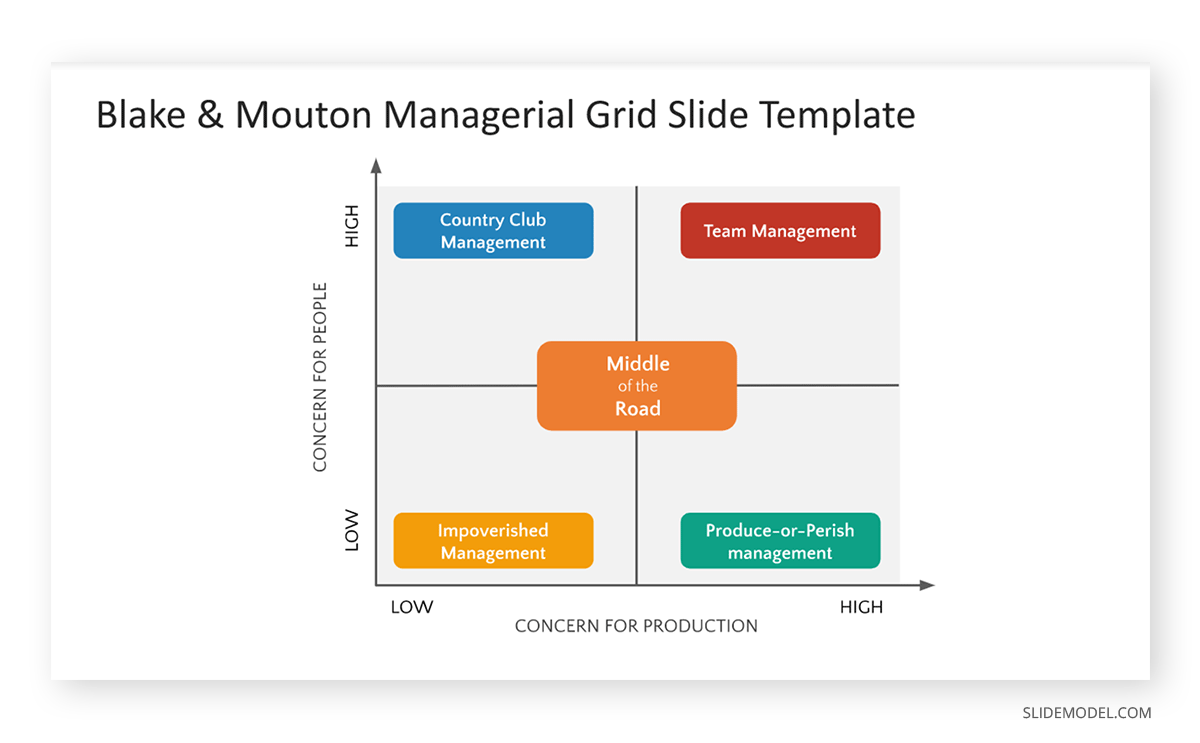
Multichapter Presentation
Does your training content span long chunks of information? Separate it into digestible sections and create a multichapter training presentation. If it still feels very long, separate each chapter into a lesson of a comprehensive digital course. This multichapter presentation template will help you either way. Plus, it will add considerable visual value to the deck as a whole.
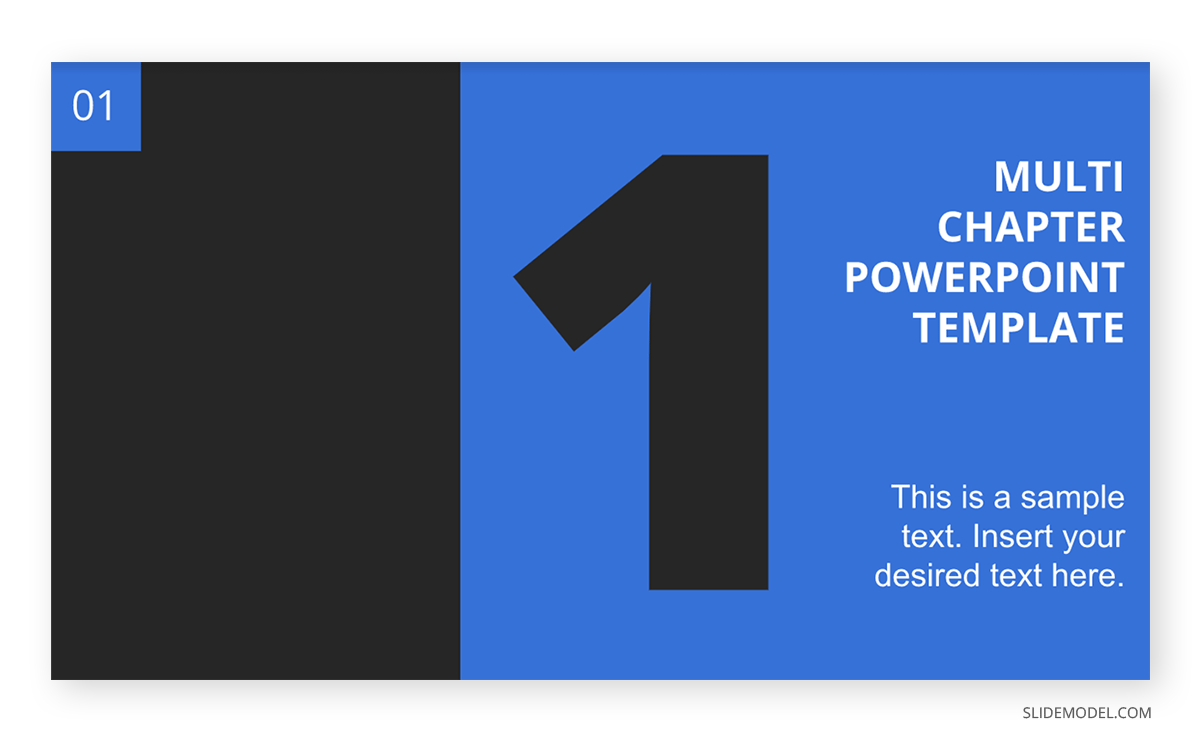
SWOT Analysis
Teaching the SWOT Analysis process is best achieved with a “start big and continue into the details” presentation structure. This 5-slide template starts with the main idea and then delves deeper into each section. A visual structure like this also works for any concept that needs explanatory simplification. Simply separate the main concept into four parts and create a further slide for each.
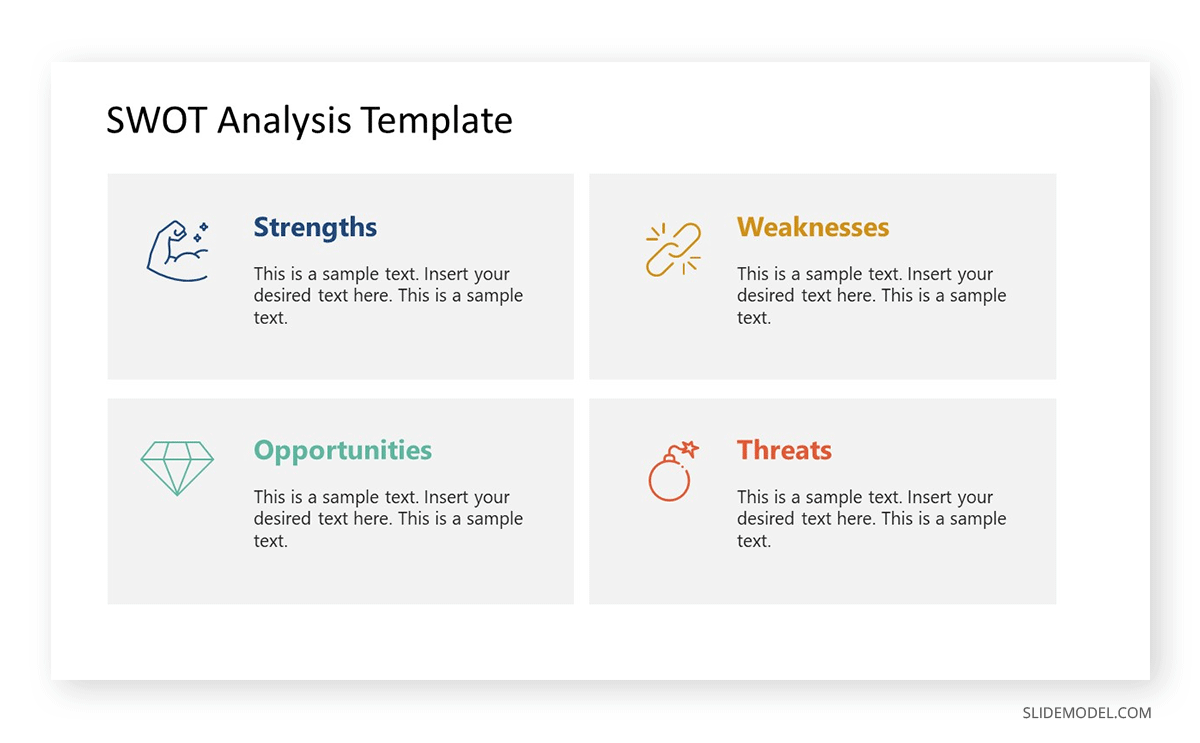
5Cs of Customer Service
Nothing exudes versatility as much as infographics. This template has one function, to describe and analyze the 5Cs of customer service . Nevertheless, you get six visually different infographic compositions for the same topic in one template. How else can your content be separated into five sections with the same first letter? This—all words with the same first letter—is a mnemonic technique that will help your learners absorb and retain information.
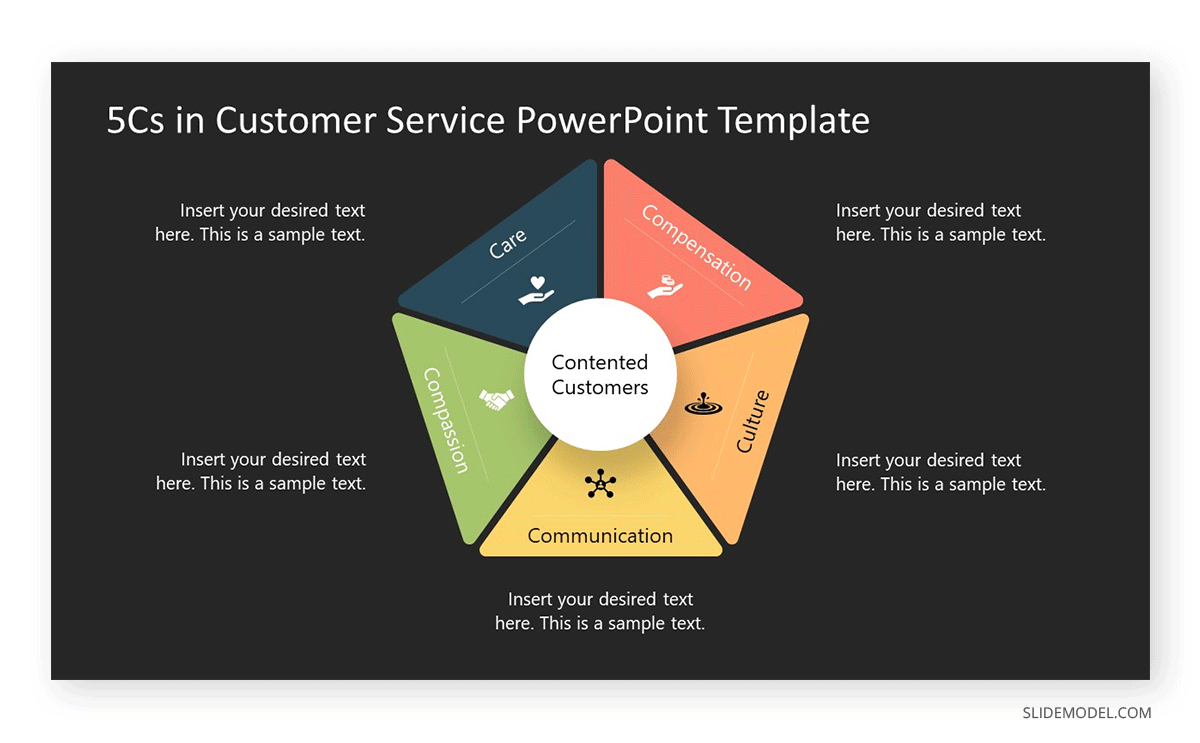
How to Deliver Your Training Presentation
How will you deliver the training presentation to your learners? Depending on the company culture and working model, your training presentation will appear in any of the following scenarios.
1. As visual support to your In-person group training session.
The in-person group training session is the most common—until the pandemic changed many things. Your training presentation is the visual support during the event.
Here are some tips for delivering a presentation during a group training session.
- Practice your ability to talk to a group. Notice your voice inflections or lack thereof. Practice the lesson with the training slides to support your spoken or activity-based teaching material.
- Remember that presenting a business presentation and teaching with a training presentation aren’t the same. If you’re new to in-person group training, research to learn and practice instruction skills.
- While training, maintain constant interaction with the learners. Ask them questions, and let them ask you questions. Invite anyone interested to join the online whiteboard for notetaking and mind-mapping the lesson.
2. As Part of a Live Online Session for Hybrid Teams.
Online, blended learning is quickly becoming popular with L&D teams. But how does it work? And why is it so special?
When you have hybrid teams with some employees in-office, others at home, and even more in other parts of the world, you need training solutions that work for everyone.
For the SCRUM training, we’d do the following:
- Prepare the training presentation slide deck.
- Organize a space for the in-person group and plan the event.
- Set up a camera to record the lesson or training session.
- Invite all employees to the session and offer them options of attendance; in-person, online, and live, watching the event recording.
- Get set up to stream the session live. You can use a webinar tool like Streamyard or the one inside your LMS platform. Someone might need to help so you can concentrate on the training rather than the technical tasks.
- Stream the lesson live and record it. On Chromecast , choose to use the split screen. One side shows the video of you teaching, and the other is the training presentation you prepared.
- Send the recording to the employees that didn’t attend in person or live online.
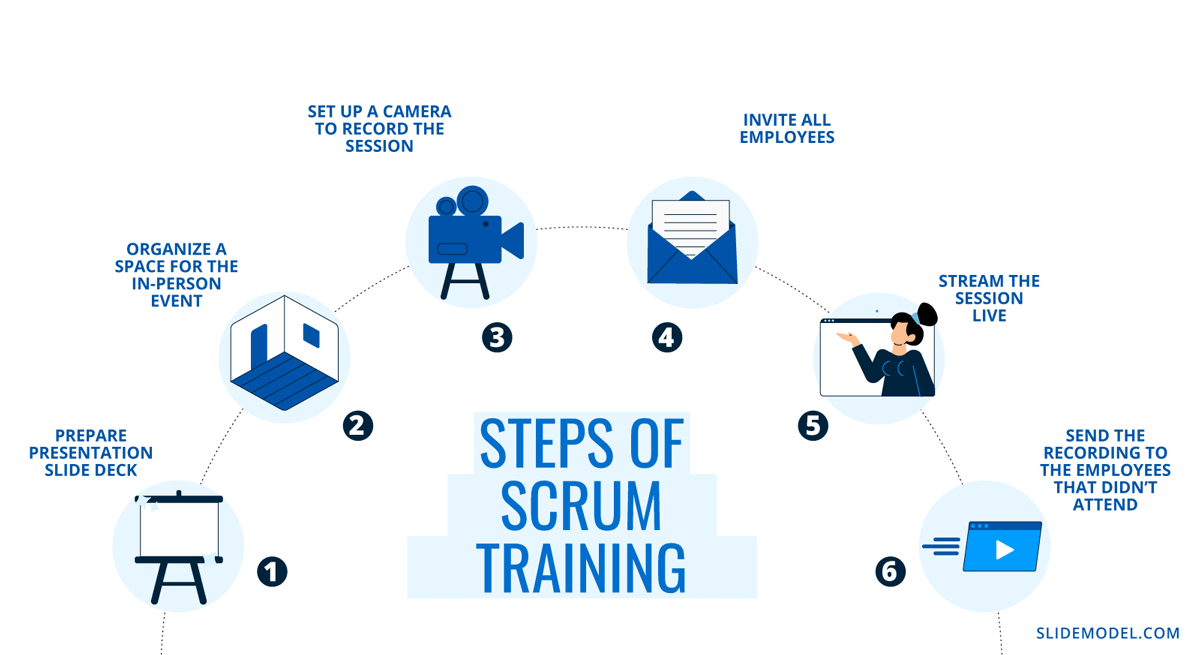
3. As a lesson in a digital course
Your training presentation can be its own course or part of a bigger one. In a comprehensive multi-lesson course, each section has its training presentation or a combination of presentations and other material. Use e-learning tools like SCORM and xAPI to create courses learners can do at their own pace, which you can keep track of.
Create your SCORM and xAPI courses with PowerPoint, SlideModel, and the iSpring PPT plugin . Once finished, upload it all to your LMS platform and enroll employees to learn.
What’s the difference between SCORM and xAPI? The visual below has all the answers.
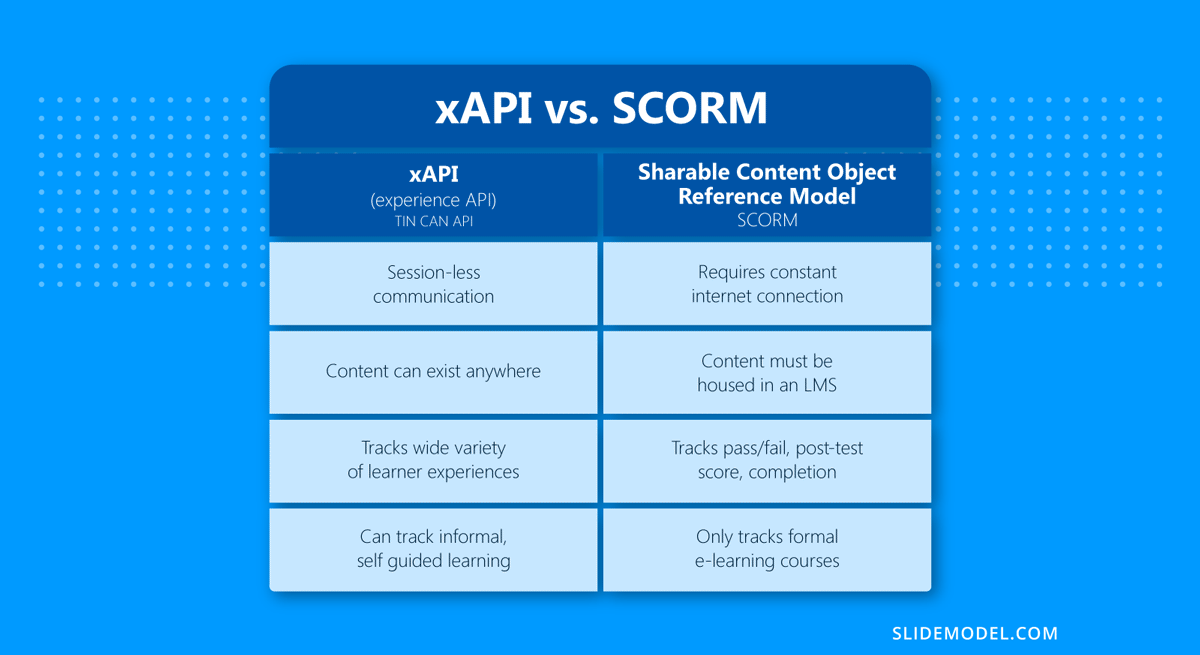
Read our guide on how to create an online course for detailed instructions and tips to make your course stand out.
3. As a PDF document
Delivering a training presentation as a PDF document shouldn’t be your first choice, but consider it for those employees that prefer learning that way. The same training presentation you create for in-person training, online learning or hybrid sessions can be downloaded as a PDF and shared via email or through the learning portal.
Takeaways for how to create successful PowerPoint Training Presentations
Optimize your training presentations to be as efficient as possible using instructional design techniques from the pros. Start with your trusty authoring combination of PowerPoint and SlideModel, and add an iSpring design plugin to complete the toolkit. Follow the steps in the sections above and then some.
Implement Interactivity
Add interactivity to your training presentations to make them more engaging while touching on more learning styles. Interactivity can be as simple as a navigation menu between slides, dialogue simulations, and quick in-slide quizzes. Use xAPI and an LMS to create interactive training presentations for any topic.
After discussing the importance of interactivity, take a look at our 5-topic training presentation template showcased in the following video. With a tabbed menu, this training PPT template is ideal for presenting the agenda of your training session and delivering it in a streamlined manner. Each tab can represent a unique topic or module, making it easier for your audience to follow along and understand the progression of your training. The slide layout not only enhances visual appeal, making it more engaging than traditional slides, but also promotes organized content delivery.
Animated presentation templates, such as the one shown, are an effective way to captivate your audience and make the learning experience more memorable. This kind of animations add an element of surprise and engagement that static slides might lack. When paired with interactive elements mentioned earlier, such training templates can transform your training presentations into immersive learning experiences.
Add In-Slide Video
Hybrid learning and online learning have a wide berth of possibilities. One is in-slide video recordings of you—the training presenter—talking to the audience on the other side of the screen.
This is especially practical for digital training presentations that never had an in-person session and instead are all done online. Use tools like Loom and Camtasia to record yourself speaking as you flip through the training slides. Then share the final video output on your company’s learning platform.
Offer Supplemental Material
Regardless of how you deliver your training deck, it’s always a good idea to offer supplemental material for the learner. Let’s look at some ideas:
- If you deliver the training presentation as a video with much narration, offer a PDF transcript for download.
- On an LMS platform, add printable PDF worksheets and further reading material.
- Before or during an in-person session, give handouts and worksheets.
- In a hybrid webinar, share links to online games that help reinforce the topic.
- In any scenario, offer further resources for self-paced learning.

Incorporate Gamification
One of the best teaching techniques for turning training presentations from meh to memorable is gamification. Using games and game-like visual qualities helps learners capture and retain information better. Gamification techniques like badges, challenges, and competition elevate the learner’s feeling of happiness and contentment. They enjoy the process more and therefore learn more effectively.
Cover Multiple Platforms
Reach all employees where they are by creating and delivering versatile training presentations that are viewable on any device, from wall projectors to mobile phones. Create interconnectivity between them with downloads, digital whiteboards for notetaking, online chatrooms, handouts, etc.
Don’t forget also to follow accessibility standards. For example, closed caption subtitles on videos and e-reader-compatible text.
Share Questionnaires And Surveys At The End
Do you agree with the business notion that nothing in business is worth it unless you can track it? If so, then your training presentations must have a callback. Shortly after the learner has attended, watched, or listened to your training presentation, send them a short survey to gauge their satisfaction. Combine this with testing and quizzing results, and over a short time; you’ll have a good grasp on the effectiveness of your training.
Give a Certificate of Completion
Offer your learners a certificate of completion. As its name indicates, a certificate is essential for certifying that a person has taken your course. Create a visual certificate that you can send as a pdf in an email. Include all the necessary information for the learner to mention the completed course on their LinkedIn profile.
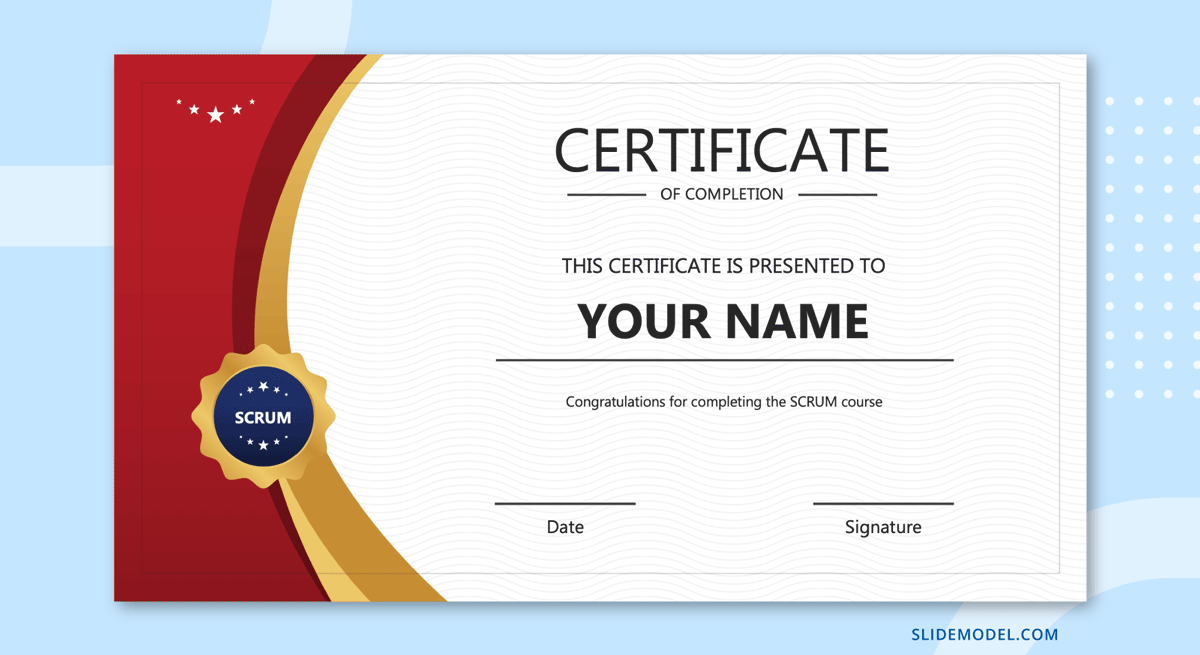
In less than three thousand words, you learned why training presentations are important for business, how to create and deliver them, plus tips on how to make your training presentations amazing.
Your L&D team and all your trained employees will benefit from optimized training presentations that use SlideModel templates for PowerPoint and Google Slides. Support your learners with visuals and instructional infographics. Start downloading educational templates today.
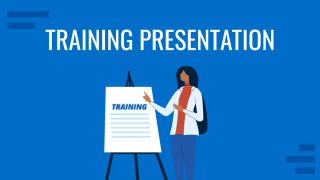
Like this article? Please share
Presentation Approaches, Presentations Filed under Education , Presentation Ideas
Related Articles

Filed under Design • March 27th, 2024
How to Make a Presentation Graph
Detailed step-by-step instructions to master the art of how to make a presentation graph in PowerPoint and Google Slides. Check it out!

Filed under Presentation Ideas • February 29th, 2024
How to Make a Fundraising Presentation (with Thermometer Templates & Slides)
Meet a new framework to design fundraising presentations by harnessing the power of fundraising thermometer templates. Detailed guide with examples.

Filed under Presentation Ideas • February 15th, 2024
How to Create a 5 Minutes Presentation
Master the art of short-format speeches like the 5 minutes presentation with this article. Insights on content structure, audience engagement and more.
Leave a Reply

Blog – Creative Presentations Ideas
infoDiagram visual slide examples, PowerPoint diagrams & icons , PPT tricks & guides

7 Sections for Effective Presentation Training Slides
Last Updated on March 11, 2024 by Rosemary
Are you delivering a public speaking or presentation skills training? Find some inspiration for your slides here.
Explore our Business Performance PPT Reports category on the website for more resources to boost your presentation impact.
In this article I suggest how you can prepare engaging PowerPoint visuals covering presentation training topics, specifically:
- How to illustrate presentation structure and content types on a slide
- Visualizing speaker and listener types
- Presenting various meeting room setups
- How to show hints for preparing speech and presentation itself
- Closing the presentation training with a recap and summary slide
Whether you are a professional communication trainer or a beginner, I believe you can find some handy examples.
Note: All slide examples are from the Presentation Skills Training PPT Toolbox . Click the pictures to see details.
We’re talking a lot here about presentation content, right visualizations, showing concepts… Let’s get back tot he roots and recall the very basics of high-quality presentation and how it should look like.
Words are the most powerful drug used by mankind. Rudyard Kipling
Rudyard Kipling was right that words are a very powerful tool, however, if used and delivered effectively. Let’s break down some theories into short sections.
#1: Illustrating Presentation Structure by Drawing

In my presentation experience, I see usually those 3 most popular kinds of structures: classical 3-part, monotonous and ‘Hollywood-movie’ style. When you explain such structures, I suggest you draw a simple diagram like the one above. Either on a flipchart or if you want to have materials prepared before, then make a slide with those speech flow diagrams.
You can either show them all together on one slide for comparison or put each on a separate slide. This way you will get attention and focus on one presentation type at a time.
For discovering more tips for structuring presentations I recommend checking Nancy Duarte’s blog series: Structure Your Presentation Like a Story and her book Resonate.
4MAT – My Favorite Presentation Structure

Out of various speech structures, I like the most the 4MAT concept. It is pretty simple and works for me.
I suggest that when you create a presentation, ask yourself those four questions. Those are questions listeners have in their heads when they listen to you.
Using the 4MAT framework helps me to see things from the viewpoint of my audience and be sure listeners will get their ideas right.
#2: Explore Presentations by Content

It’s obvious the presentation content defines the presentation type. However, it’s good to remind yourself what’s the goal of the presentation – to inspire or to entertain only? Do you want to persuade your audience of your idea or only to inform, to give a report?
Some examples:
- For inspiring presentations: Talks on TED.com are the best examples. Or check one of Elon Musk’s speeches on the Mars Mission . Politicians use this presentation to type a lot
- Informative presentations are usually used when you do a project summary report or yearly business review. Unfortunately, lots of school lectures fall into this category, even though the teachers should work on moving towards an inspiring segment with a bit of entertainment to keep kids attention.
- For persuasive presentations just think of the last sales or marketing presentation you experienced.
- For entertainment – check out any stand-up comedy talks, for example, this (being a father I really appreciate that later talk).
- A mixture of entertainment and information is e.g. famous John Oliver show
You have to make sure that your speech is relevant to the audience you’re speaking to.
#3: Analyze the Speaker Types

When teaching about properly preparing a talk, you need to consider also different speaker types classification. I put here four kinds of presenters: a typical talkative salesman style, an analyst type who likes to go into details (sometimes too much), a monotonous teacher style (that would need a point of wake up) and an involving storyteller. However, you can think of other examples based on your experience.
Depending on the particular speaker type, you can use its strong sides to build the presentation differently and also support it with proper visuals. For instance, for a talkative salesman, the agenda slides can provide a structure to follow. On the other hand, a too much detailed analyst on lengthy teacher talk can benefit from having a strong visual section slides that will wake up your audience.
#4: Analyze the Listener Groups

Knowing the speaker type is one thing. However, even more, important is to examine the audience carefully to reach them best.
Every presenter should ask first “Who are my listeners”? Do they prefer a formal or informal way of communication? Are they feelers or thinkers (see MBTI types of personality )? Will the audience be active or rather passive during the talk?
When doing a presentation training, you should address this key question. And what is the better way than to illustrate it e.g. by a set of icons?
In my slides, I added there also a hand drawn chart where you can position the major listeners’ types. Then you can place and move around the central circle to show various audience cases on a knowledge and involvement scale.

In a training, you can include a similar chart (or apply those presentation training diagram slides ) for determining the audience type.
#5: Room set up – the importance of the presentation environment

After talking about the presentation audience and speaker types, a good presenter should think also about the place where the talk will take place. Choosing a suitable environment is an important factor for the effective delivery of the speech.
I distinguish here five common kinds of room setups: classroom, multiple groups environment, interactive roundtable, big theater and sitting in a circle. Each one suits a different purpose. Some of these you need to arrange before, of course, you will know if you speak at a big conference that there will likely be a theater-like room. However, sometimes even a small change of sitting arrangements can provide a totally different atmosphere for a speech.
- Classroom setup assumes rather one-directional communication from teacher to students.
- Roundtable or sitting in a circle encourages discussion and underlines equality of all participants.
- Having clusters of multiple groups is great if you want to have several teams working on some group work.
#6: Presenting Hints for Speech Preparation

If you want to add a list of things to remember before making a presentation, I suggest you try to illustrate each point with some image, as I did above. This creates a better mnemonic association for each point and people will remember the hints longer. Even better, replace the bullet points with a vivid diagram along with keeping the icons.
#7: Presenting Summary of the Training

At the end of the training, remember to repeat the main message once again. Present the main conclusion, and give your audience something to think about. You can write it down on a slide clearly, without too many distractions. Or write it by hand on a board or flipchart.
Resources for Presentation Training
Besides the links I shared above I recommend those further reading and resources
- Toastmasters International public speaking clubs all over the world
- Books: Slide:ology Nancy Duarte and Presentation Zen by Garr Reynolds
- Our PowerPoint Training templates for various soft-skills training, see details below.
- Feedback Training Presentation Hints
- Motivation Training Presentation Template & Ideas
So if you’re having training on how to create and deliver a presentation, you can reuse slides from our collection in your projects. Or just get inspiration from my slides and create them yourself.
If you decide to go for our hand-drawn style diagrams, you will be able to easily edit all content, adapt the colors to your brand, and add the whole slides or particular charts to your training presentation.
For more inspiration, subscribe to our YouTube channel:
Graphics resource: Presentation skills training toolbox
You can also check the presentation template we’ve designed with illustrations of types of speakers or presentation structures:
Presentation Skills Training Toolbox
If you like such scribble style, see the complete All Scribble Symbols Bundle , with over 250 handwritten hand-drawn symbols and shapes.
About the author: Peter Zvirinsky is a slide design trainer and the founder of infoDiagram. He is helping presenters, trainers and various business managers to communicate their ideas in clear visual way usually in form of PowerPoint slides. Peter loves changing text information into simple diagrams and he wants to inspire also others to use this visualization process in everyday life. Reach out to Peter on LinkedIn or via his slide design & training website.
Published by
Chief Diagram Designer, infoDiagram co-founder View all posts by Peter Z
We use essential cookies to make Venngage work. By clicking “Accept All Cookies”, you agree to the storing of cookies on your device to enhance site navigation, analyze site usage, and assist in our marketing efforts.
Manage Cookies
Cookies and similar technologies collect certain information about how you’re using our website. Some of them are essential, and without them you wouldn’t be able to use Venngage. But others are optional, and you get to choose whether we use them or not.
Strictly Necessary Cookies
These cookies are always on, as they’re essential for making Venngage work, and making it safe. Without these cookies, services you’ve asked for can’t be provided.
Show cookie providers
- Google Login
Functionality Cookies
These cookies help us provide enhanced functionality and personalisation, and remember your settings. They may be set by us or by third party providers.
Performance Cookies
These cookies help us analyze how many people are using Venngage, where they come from and how they're using it. If you opt out of these cookies, we can’t get feedback to make Venngage better for you and all our users.
- Google Analytics
Targeting Cookies
These cookies are set by our advertising partners to track your activity and show you relevant Venngage ads on other sites as you browse the internet.
- Google Tag Manager
- Infographics
- Daily Infographics
- Graphic Design
- Graphs and Charts
- Data Visualization
- Human Resources
- Training and Development
- Beginner Guides
Blog Marketing
15 Interactive Presentation Ideas to Elevate Engagement
By Krystle Wong , Aug 04, 2023

As attention spans continue to shrink, the challenge of engaging audiences in a short timeframe has never been more significant. Let’s face it — grabbing and keeping your audience’s attention can be quite the challenge, especially when time is ticking away. But fear not, I’ve got the perfect solution: interactive presentations!
Believe it or not, creating an interactive presentation is easier than you might think. In this guide, I’ll show you how to effortlessly turn ordinary slides into captivating experiences with 15 interactive presentation ideas that will leave your audience begging for more. From quirky polls and fun games to storytelling adventures and multimedia magic, these ideas will take your presentation game to the next level.
Venngage is a game-changer when it comes to empowering interactive presentations. With just a few clicks, users can customize their favorite presentation templates , add multimedia content and create immersive experiences that leave a lasting impact. Whether you’re a seasoned presenter or a newcomer, get started with Venngage to elevate your presentation game to new heights of engagement and creativity.
Click to jump ahead:
What is an interactive presentation?
15 ways to make a presentation interactive, 7 best interactive presentation software, what are some common mistakes to avoid when creating interactive presentations, interactive presentation faqs, how to create an interactive presentation with venngage.

An interactive presentation is a dynamic and engaging communication format that involves active participation and collaboration between the presenter and the audience. Unlike traditional presentations where information is delivered in a one-way manner, interactive presentations invite the audience to interact, respond and contribute throughout the session.
Think of it as a two-way street where you and your audience have a friendly chat. It’s like playing a fun game where you ask questions, get live feedback and encourage people to share their thoughts.
To make a good presentation , you can utilize various tools and techniques such as clickable buttons, polls, quizzes, discussions and multimedia elements to transform your slides into an interactive presentation. Whether you’re presenting in-person or giving a virtual presentation — when people are actively participating, they’re more likely to remember the stuff you’re talking about.

Interactive presentations leave a lasting impression on the audience. By encouraging active participation and feedback, interactive presentations facilitate better understanding and knowledge retention. Here are 15 innovative 5-minute interactive presentation ideas to captivate your audience from start to finish:
1. Ice-breaker questions
Start your presentation with intriguing and thought-provoking questions or a fun icebreaker game. These questions should be designed to pique the audience’s curiosity and encourage them to think about the topic you’ll be covering. By doing so, you create an immediate connection with your audience and set the stage for a more engaged and attentive audience.
For example, if you’re giving a business presentation about management and leadership training, you could ask audience questions such as “What’s the best business advice you’ve ever received, and how has it impacted your career?”

2. Live polling
Incorporate live polls during your presentation using audience response systems or polling apps. This allows you to collect real-time feedback, opinions and insights from active participants. Live polling encourages active participation and involvement, making your presentation feel like a collaborative and interactive experience.
3. Q&A sessions
Encourage the audience to ask questions throughout your presentation, especially for pitch deck presentations . Address these questions in real-time, which fosters a more interactive and dynamic atmosphere. This approach shows that you value the audience’s input and promotes a two-way communication flow.
4. Clickable buttons
Add clickable buttons to your slides, allowing the audience to navigate to specific sections or external resources at their own pace. For example, you could include links to your social media accounts or extra reading materials in your education presentation to give further information about the topic and get your students engaged. By providing this autonomy, you empower the audience to explore areas of particular interest, creating a more personalized and engaging experience through your interactive slideshow.

5. Storytelling
Incorporate anecdotes or personal stories related to your topic. Storytelling is a powerful way to emotionally connect with your audience, making your presentation more relatable and memorable. A little storytelling along with a set of creative slides draws the audience in and keeps them engaged as they follow the narrative.
6. Interactive charts and graphs
Use interactive charts and graphs that respond to user input to make your presentation interactive. For instance, allow the audience to click on data points to view more detailed information or to change the displayed data series. Creating charts with interactive visuals help the audience interact with the data, fostering better understanding and engagement.
7. Animated infographics
Add animations to your infographics, making them visually dynamic and progressive. Animated infographics reveal information gradually, keeping the audience curious and attentive. This transforms complex data into an easily digestible and engaging format.
Venngage’s extensive library of infographic templates is a powerful tool to visualize data and elevate the interactivity of your presentations. Personalizing the visuals ensures a cohesive and professional look throughout your interactive presentation. The templates are highly customizable, allowing you to adjust colors, fonts, and styles to match your presentation’s theme and branding.

8. Gamification
Introduce an interactive quiz, puzzles, or challenges related to your presentation content. Gamification adds an element of fun and competition, motivating the audience to participate actively and boosting their learning experience. Here are some gaming presentation templates you could use.

9. Virtual reality (VR) or augmented reality (AR)
If applicable, leverage VR or AR technologies to provide immersive experiences. These interactive presentation tools transport the audience into a virtual or augmented environment, making your presentation more captivating and memorable.
10. Collaborative whiteboarding
Get your audience involved in your presentation by utilizing digital whiteboards or collaborative tools to brainstorm ideas collectively. This fosters teamwork and creativity, enabling the audience to actively contribute and feel a sense of involvement in the presentation.

11. Hyperlinked text
Keep the information in your slides minimal with a simple presentation and incorporate hyperlinks to direct viewers to relevant websites or blogs , resources, or additional information. This encourages self-exploration and gives the audience the opportunity to delve deeper into topics of interest.
12. Role-playing
Engage the audience in role-playing scenarios to explore different perspectives. Role-playing promotes active learning and helps the audience relate the content to real-life situations, enhancing their understanding and retention.
13. Embedded videos
Include video clips in your slides to provide visual explanations, demonstrations, or interviews. Videos add a dynamic element to your presentation, enriching the content and keeping the audience engaged.

14. Audience-generated content
Encourage the audience to contribute ideas, stories or examples related to your professional presentation . Audience-generated content fosters a sense of ownership and involvement, making the presentation more interactive and personalized.
15. Slide transitions
Use slide transitions to create smooth animations between slides. Well-planned transitions maintain the audience’s interest and keep the presentation slides flowing seamlessly.
Interactive elements aside, enhance your presentation with these guides on how to summarize information for a captivating presentation and how to make a persuasive presentation to captivate your audience.

If you’re looking to create engaging and interactive presentation slides that captivate your audience, these presentation software options are sure to elevate your game:
Prezi is renowned for its dynamic and non-linear presentation style, enabling users to craft visually stunning and interactive presentations. With an array of templates and animation effects, Prezi enhances audience engagement, making your presentations more captivating and memorable.
2. Mentimeter
Mentimeter serves as an audience response system, empowering real-time interaction during presentations. Users can create interactive polls, quizzes, word clouds and more, allowing the audience to respond using their smartphones or other devices. This fosters active participation and provides valuable feedback instantly.
3. Google Slides
Google Slides is a free cloud-based presentation software that not only offers collaboration features but also enables real-time interactions. It includes add-ons and third-party integrations to further enhance interactivity, making it an excellent choice for collaborative and engaging presentations.
4. Microsoft PowerPoint
PowerPoint, a classic presentation software, has evolved to incorporate more interactive features like live captions, real-time collaboration and interactive elements such as quizzes and forms. With its familiar interface and versatile functionalities, PowerPoint remains a reliable choice for interactive presentations.
5. Prezentor
Prezentor caters to sales-oriented presentations focusing on interactive storytelling and data-driven content. It offers analytics to track audience engagement and behavior during presentations, allowing you to fine-tune your approach and keep your audience hooked.
6. Opinion Stage
Opinion Stage is a visual and interactive data collection tool designed to engage and excite audiences whether sitting in a lecture hall, participating in a live Zoom, or watching an on-demand webinar. The Opinion Stage tools are simple and intuitive, making it easy to create attention-grabbing quizzes, surveys, and polls in minutes. A great way to spice up any presentation, encourage audience participation, and collect authentic feedback.
7 . Venngage
Venngage stands out as a versatile design tool that facilitates the creation of interactive infographics, data visualizations and presentations with ease. Offering various interactive elements and animations, Venngage empowers you to craft visually appealing and engaging presentations effortlessly.
With these interactive presentation software options at your disposal, you can unleash your creativity and deliver presentations that leave a lasting impact on your audience. So, go ahead and make your presentations interactive, captivating and memorable!
For more presentation software options, check out this blog on the 12 best presentation software for 2023.

Creating interactive presentations can be a game-changer for engaging your audience and enhancing your presentation skills, but steering clear of common pitfalls is essential. Here are some key mistakes to avoid when crafting your interactive presentations:
1. Overloading with interactivity
While interactivity is fantastic, bombarding your audience with too many interactive elements can backfire. Strive for a balanced approach that enhances engagement without overwhelming your listeners.
2. Ignoring audience relevance
Failing to tailor interactive elements to your audience’s interests and preferences can lead to disconnection. Make sure your interactions resonate with your specific audience for a more meaningful experience.
3. Not testing interactive elements
Skipping thorough testing of interactive features before showtime can spell disaster. Avoid technical glitches by diligently testing all interactive components in advance.
4. Poor timing and pace
Timing is everything, especially with interactive activities. Ensure seamless integration by planning your key points and the timing of your interactive elements carefully.
5. Lack of clear purpose
Every interactive element should serve a purpose and contribute to your presentation’s objectives. Don’t add interactions just for the sake of it — ensure they add value and align with your message.
6. Failing to engage beyond interactivity
While interactive elements are powerful tools, remember that content is king. Combine your interactive features with compelling storytelling and valuable insights to create an immersive and impactful presentation.
Incorporating animated slides into your interactive presentations enhances the overall appeal and interaction, turning an ordinary presentation into an engaging experience. Try it out with one of our animated presentation templates to get started.

How do you start an interactive presentation?
Begin by grabbing the audience’s attention with an intriguing question or a surprising fact, setting the tone for a dynamic and engaging session.
Which type of presentation is the most interactive?
Workshops and seminars are often the most interactive types of presentations as they encourage active participation, discussions and hands-on activities.
How can interactive presentations enhance audience engagement?
Interactive presentations foster a two-way communication flow, involving the audience through polls, quizzes, discussions and multimedia elements, leading to increased interest, attentiveness and better retention of information.
What are some common interactive elements to include in a presentation?
Common interactive elements include clickable buttons, hyperlinked text, polls, quizzes, interactive charts, multimedia content and audience participation activities.
Can interactive presentations be used for educational purposes?
Absolutely! Interactive presentations are highly effective for educational purposes as they promote active learning, encourage critical thinking, and provide real-time feedback and knowledge exchange opportunities.
Need inspiration on how to give an engaging presentation ? Here are 120+ presentation ideas you could use.

Venngage makes it easy for anyone to infuse interactivity into their presentations. From clickable buttons and hyperlinked text to interactive infographics and dynamic charts, Venngage offers a diverse range of interactive elements to captivate and engage the audience. Here’s how you can make your presentation more fun and interesting with Venngage:
- Sign up or log in to Venngage to access the platform.
- Choose a presentation template or start with a blank canvas to begin designing your interactive presentation.
- Add and edit slides in the Venngage editor to structure your presentation content effectively.
- Customize the design by selecting themes, fonts, colors and backgrounds to match your style and branding.
- Use interactive elements like buttons, links, pop-ups and hover effects to engage the audience during the presentation.
- Enhance engagement by incorporating interactive media such as videos and audio clips.
- Preview and test your entire presentation to ensure everything works smoothly before presenting it to your audience.
- Save your interactive presentation on Venngage and share it online or download it in various formats for presenting purposes.
Well, I hope these 15 5-minute interactive presentation examples can help unlock a new level of audience engagement for your next presentation. From fun quizzes and interactive storytelling to multimedia magic and gamified challenges, the possibilities are endless. So, don’t be afraid to experiment, tailor the ideas to suit your audience members and let your creativity shine.
That said, remember to strike a balance and keep the interactivity purposeful and relevant. Some common mistakes to avoid when creating interactive slides include overloading the presentation with too many interactive elements and failing to align the interactive elements with the overall presentation goals and content.
Got it? Great. Now let’s turn that boring presentation around!
- Phone: +90 (212) 875 19 08
- E-Mail: [email protected]
- Company Profile
- Company Policy
- Mission and Vision
- Certificates
- Aluminium Windows
- Aluminium Doors
- Aluminium Sliding Elements
- Aluminium Curtain Walls
- Aluminium Skylight Elements
- Aluminium Frames for Safety and Security
- Aluminium Conservatories
- Metal Panel Sheet Claddings
- Aluminium Entrance Frames
- Glass Structures
- Complementary Items
- Lightweight Steel Structures
- Human Resources OPEN
First successful projects, then lasting relationships!
As it has been in the past 40 years, Mimsa believe in providing competitive prices without compromising their principles of quality. We have managed to create lasting relationships based on honesty and cooperation while adding new customers each year.
Nothing is more important for us than Customer satisfaction!
Mimsa prioritizes customer satisfaction in the services they provide, and strives to understand the customers’ requests thoroughly in order to fulfil their needs and expectations. According to Mimsa Aluminium, every single customer should always be provided with the quality and services above expectations.
Every single completed project is the beginning of a lasting relationship for us.
Mimsa executes every project with experience and knowledge, while continuously improving itself and its high-quality production. Therefore, Mimsa never regards a project as a completed business. Every single project is a successful representation of lasting relationships. Thus, Mimsa pay great attention to post-sale support and keep on supplying uninterrupted support to their customers after completion.
It is very important for us that every single project we execute creates value to our workers, community and environment!
Aiming to create value for the community, environment and humankind in each project. Mimsa perceive that the occupational training of its employees and the new entrants to the workforce gets these individuals well equipped for the industry and community, and so does whatever needed without second thoughts.

- Victor Mukhin

Victor M. Mukhin was born in 1946 in the town of Orsk, Russia. In 1970 he graduated the Technological Institute in Leningrad. Victor M. Mukhin was directed to work to the scientific-industrial organization "Neorganika" (Elektrostal, Moscow region) where he is working during 47 years, at present as the head of the laboratory of carbon sorbents. Victor M. Mukhin defended a Ph. D. thesis and a doctoral thesis at the Mendeleev University of Chemical Technology of Russia (in 1979 and 1997 accordingly). Professor of Mendeleev University of Chemical Technology of Russia. Scientific interests: production, investigation and application of active carbons, technological and ecological carbon-adsorptive processes, environmental protection, production of ecologically clean food.
Title : Active carbons as nanoporous materials for solving of environmental problems
Quick links.
- Conference Brochure
- Tentative Program

literary analysis essay on the birthmark

A Summary and Analysis of Nathaniel Hawthorne’s ‘The Birthmark’
By Dr Oliver Tearle (Loughborough University)
‘The Birthmark’ is a short story by the nineteenth-century American writer Nathaniel Hawthorne, first published in 1843. Although not as well-known as ‘Young Goodman Brown’ or ‘The Minister’s Black Veil’, ‘The Birthmark’ is an intriguing tale which, like those more famous stories, contains ambiguous symbolism within its straightforward plot.
You can read ‘The Birthmark’ here before proceeding to our summary and analysis of Hawthorne’s story below.
‘The Birthmark’: plot summary
The protagonist of ‘The Birthmark’ is Aylmer, a ‘natural philosopher’ (what we would now call a ‘scientist’), who is revered throughout the scientific community for his genius. He is married to Georgina, who is praised for her beauty. However, Georgina has one glaring imperfection: her left cheek contains a birthmark or blemish, a small crimson mark in the shape of a hand.
Aylmer proposes to remove the birthmark so as to make his nearly-perfect wife completely perfect in every physical aspect. Georgina eventually agrees, trusting her husband’s talents, although she is initially hurt that he finds her birthmark so shocking to look at. She comes to the conclusion that she may as well risk the experiment, since she would rather die than continue to live with such a blemish, since it generates such horror in her husband.
Aylmer shows Georgina his laboratory where he conducts his experiments. She is later shocked when she finds his journal detailing the various experiments he has conducted, and vows to trust him when he experiments on her.
Aylmer, with the help of his servant, Aminadab, creates a potion which he demonstrates on a plant, bringing its leaves back to life. Satisfied that the potion will work, Georgina then drinks it down. She falls into a slumber, and Aylmer notices that, sure enough, the hand-shaped birthmark on his wife’s cheek is fading.
When she wakes up, Aylmer shows her that the birthmark has disappeared and he has been successful. However, his wife reveals that she is dying, and shortly after this she dies in front of him.
‘The Birthmark’: analysis
Like many of Hawthorne’s stories, ‘The Birthmark’ is, at bottom, allegorical: it is about the dangers of seeking perfection, especially human perfection, of all kinds, because to do so runs the risk of destroying what makes us ‘human’ in the first place. We use the phrase ‘you’re only human’ when someone acknowledges their own flaws or mistakes.
Georgina’s birthmark is a ‘flaw’ which makes her not only human, but the woman Aylmer married in the first place. It is deliberate on Hawthorne’s part that the birthmark only becomes a problem for Aylmer after he has married her.
The birthmark also represents Aylmer’s determination to use scientific means to change nature at all costs: at one point, he calls himself a ‘sorcerer’, and he has much in common with the older magicians in folklore and literature, such as Faust or that latter-day magician, Victor Frankenstein.
He views it as a challenge, his next great project, and is committed to removing it using his own ingenuity and experimentation. He is, in a sense, another fictional scientist playing God, using his powers to try to alter what God or Mother Nature have created. In the first paragraph of the story, Hawthorne tells us,
In those days when the comparatively recent discovery of electricity and other kindred mysteries of Nature seemed to open paths into the region of miracle, it was not unusual for the love of science to rival the love of woman in its depth and absorbing energy.
This not only shows how Godlike men like Aylmer consider themselves, and their powers, to be; it also brings together the two loves of Aylmer’s life, his love of Georgina and his love of science. But in many ways his love of science will not only ‘rival’ but come to supersede his love for his wife, since he is prepared to risk her life (as proves to be the case) in order to remove the birthmark from her face.
A birthmark, in being a cosmetic defect, poses no danger to Georgina’s own health, but his own horror at it, and determination to rid himself of the ‘shudder’ which it inspires in him, convinces her to let him remove it at any cost.
Indeed, Aylmer’s dream is revealing in that, as so often in literary works, it acts as a premonition. Early on in ‘The Birthmark’, Hawthorne establishes a link between Georgina’s outward appearance, including that hand-shaped birthmark, and her inner self, symbolised by the heart : he describes the blemish as a ‘mimic hand, now vaguely portrayed, now lost, now stealing forth again and glimmering to and fro with every pulse of emotion that throbbed within her heart’. Then comes his dream:
Aylmer now remembered his dream. He had fancied himself with his servant Aminadab, attempting an operation for the removal of the birthmark; but the deeper went the knife, the deeper sank the hand, until at length its tiny grasp appeared to have caught hold of Georgiana’s heart; whence, however, her husband was inexorably resolved to cut or wrench it away.
Despite this warning, Aylmer – supported by Georgina – remains determined to find a way of ridding his wife of this blemish, with the inevitable tragic results. He has triumphed in a scientific sense, but he has failed in a bigger one.
Indeed, if we wished to reduce ‘The Birthmark’ to a single ‘moral’ (a dangerous thing to do, but a handy ‘way in’ to the story), we could do worse than to summarise it as being about the dangers of focusing too much on one problem without taking into account the broader context of that problem.
Aylmer’s monomaniacal focus on his wife’s birthmark blinds him to her otherwise beautiful features, and he is not unlike the proverbial man who found a rat in his house so burned the place to the ground. In seeking to destroy one unwanted detail, he unwittingly destroys all of the things around it which he loved and treasured.
2 thoughts on “A Summary and Analysis of Nathaniel Hawthorne’s ‘The Birthmark’”
- Pingback: 10 of the Best Nathaniel Hawthorne Novels and Stories Everyone Should Read – Interesting Literature
- Pingback: A Summary and Analysis of Nathaniel Hawthorne’s ‘Rappaccini’s Daughter’ – Interesting Literature
Leave a Reply Cancel reply
Discover more from interesting literature.
Subscribe now to keep reading and get access to the full archive.
Type your email…
Continue reading
The Birthmark

32 pages • 1 hour read
A modern alternative to SparkNotes and CliffsNotes, SuperSummary offers high-quality Study Guides with detailed chapter summaries and analysis of major themes, characters, and more. For select classroom titles, we also provide Teaching Guides with discussion and quiz questions to prompt student engagement.
Story Analysis
Character Analysis
Symbols & Motifs
Literary Devices
Important Quotes
Essay Topics
Discussion Questions
Summary and Study Guide
Summary: “the birthmark”.
“The Birthmark” by Nathaniel Hawthorne (1804-1864) was initially published in the March 1843 edition of The Pioneer , a short-lived literary periodical which was also the first to showcase Edgar Allan Poe’s famous “The Tell-Tale Heart.” “The Birthmark” was later serialized in Mosses From An Old Manse , a collection of Hawthorne’s short stories, in 1846. Widely considered to be one of the preeminent American writers of the nineteenth century, Nathaniel Hawthorne enjoyed a career trajectory fairly typical of his day. He started by concentrating exclusively on short stories before later moving on to the longer novel form. He is perhaps best known for these latter works, most famously The Scarlet Letter , but his short stories played a pivotal role in guiding the nineteenth century’s titanic shift from gothic horror to science fiction. “The Birthmark” represents both of these genres, and it is also considered a seminal work of dark Romanticism . It is in the public domain and is available by open source. This guide refers to the online version offered by Project Gutenberg.
The story’s protagonist , Aylmer , is a scientist who lives during an exciting time in “the latter part of the last century” (Paragraph 1). Electricity has just been invented, as well as various other methods through which men can control the natural world. But despite Aylmer’s engagement with his work—and its tantalizing potential to discover “the secret of creative force and perhaps make new worlds for himself” (Paragraph 1)—he decides to seek out a wife. He marries Georgiana , and while he dearly loves his new bride, he is equally devoted to his scientific studies. He might come to love her more someday, the narrator explains, but only if their marriage might somehow meld with his love of science.
Get access to this full Study Guide and much more!
- 7,150+ In-Depth Study Guides
- 5,000+ Quick-Read Plot Summaries
- Downloadable PDFs
Soon after their marriage, Aylmer becomes increasingly troubled by a birthmark on Georgiana’s cheek. He asks her if she has ever considered having it removed. Georgiana replies that she is used to men perceiving the eccentricity as a positive characteristic, but Aylmer doesn’t agree. Georgiana’s face, he argues, was created nearly perfect by nature; even the slightest possible defect is “shocking.” Georgiana is deeply hurt by his comment. She is convinced that Aylmer “cannot love that which shocks [him]” (Paragraph 6).
Georgiana’s birthmark , located in the center of her left cheek, is red and shaped like a small hand. It blends in with her skin when she blushes, but stands out when she is pale. It appears to be “deeply interwoven […] with the texture and substance of her face” (Paragraph 7). Georgiana’s supporters say that she must have been touched by a fairy when she was an infant. Other woman, jealous of her incredible beauty, claim the birthmark spoils her and renders her ugly. For his part, Aylmer wishes the birthmark didn’t exist because it mars the “one living specimen of ideal loveliness” (Paragraph 7). Georgiana’s perfection in every other aspect makes Aylmer increasingly intolerant of the birthmark. For him, the birthmark comes to represent “the fatal flaw of humanity which Nature, in one shape or another, stamps ineffaceably on all her productions” (Paragraph 8).
The SuperSummary difference
- 8x more resources than SparkNotes and CliffsNotes combined
- Study Guides you won ' t find anywhere else
- 100+ new titles every month
Aylmer becomes increasingly obsessed with the birthmark, and Georgiana increasingly notices his disgust. His disapproval causes her to go pale, and her birthmark becomes much more visible. Upset, she asks Aylmer if he remembers a dream he’d had the night before. With some effort, he finally does: he dreamt that he and his servant, Aminadab , had tried to remove birthmark via an operation, but the deeper Aylmer cut, the further down he found the hand to reach, finally discovering that it was firmly wrapped around Georgiana’s heart. Instead of deterring Aylmer, the dream only makes him more determined to cut the birthmark out, despite his guilt about how far he might go to remove it, and at what cost. Georgiana claims she is willing to take on any danger necessary in the name of removing it, as she cannot stand Aylmer’s horror of her. Aylmer agrees to try and kisses her cheek—the one without the mark.
They decide to perform the operation in the laboratory where Aylmer had made many natural discoveries before, including some involving the workings of the human body. He was deterred from this line of experimentation, though, by unspecified failures. In the lab, Georgiana faints when Aylmer intends to comfort her, but he cannot help shuddering at the sight of her birthmark. He calls his servant, Aminadab, to assist him. Aminadab is a large man with shaggy hair that is smoky from the lab; the narrator contrasts his physicality with Georgiana’s “pale, intellectual” appearance, which has a “spiritual” element. Aminadab comments that were Georgiana his wife, he would leave the birthmark alone.
Georgiana wakes up in an area of the laboratory which Aylmer has redecorated to resemble a lovely apartment, fitted with several perfume lamps. The effect is magical; Aylmer is confident, feeling that he “could draw a magic circle round her within which no evil might intrude” (Paragraph 28). He calms her with pleasant optical illusions and distractions; his stories are scientific in origin, but they have a magical air about them. He presents Georgiana with a perfect flower and encourages her to pick it and enjoy it; the plan backfires, though, as it withers as soon as she touches it. Aylmer tries to take her portrait—a process evoking early photography—but the results are less than optimal: Georgiana’s birthmark is even more obvious than before. He destroys the result in acid.
After some time at work in the lab with Aminadab, Aylmer produces a vial of liquid which he claims is an “elixir of immortality” (Paragraph 43) that has an alchemical power to extend or end life, as well as the ability to remove superficial blemishes. It will not work on Georgiana, Aylmer knows, as its power is only superficial. He repeatedly asks Georgiana about her condition. Georgiana perceives that something in the apartment—the fragrances or otherwise—have begun to make her feel strange. She sees her own reflection and finds her birthmark even more repulsive than Aylmer does.
She spends time reading a book of Aylmer’s findings and feels enamored with his genius, but she “could not help but observe that his most splendid successes were almost invariably failures” (Paragraph 51). She sees these faults as proof of the limitations of human beings, and they make her love him all the more. She trails after Aylmer into the lab where he works, intending to tell him of a new symptom she is experiencing.
In his lab, the furnace is working furiously. Aylmer himself is pale and intent, watching his titration system, and he panics when he discovers Georgiana has followed him. Georgiana confronts him, and Aylmer admits that there is only one solution remaining to try to remove the mark, a new elixir, which he is working on now. Whatever the solution might be, Georgiana assents to it; back in her room, she reflects on how “honorable” Aylmer’s love is, that he is discontent with her earthly nature and strives for her perfection.
Aylmer brings her a draught, which, as he demonstrates on a diseased plant, should rid Georgiana of the mark. Georgiana drinks it with fervor and falls asleep. Aylmer takes notes on her condition, occasionally kissing the mark, though it repulses him. To his delight, as he watches, the mark begins to disappear.
Aylmer pulls back the curtain, and sunlight falls on Georgiana’s face. Aminadab laughs, and Aylmer joins him, not yet perceiving anything is amiss. Georgiana wakes and addresses Aylmer tenderly, telling him that he has acted nobly, even if he “rejected the best the earth could offer!” (Paragraph 89). She tells him she is dying. As the birthmark disappears, the treatment a success, she passes away. Aminadab laughs again: the final victory of the earthly over the celestial. The narrator concludes with a moralizing statement chastising Aylmer for seeking perfection in the mortal realm.

Don't Miss Out!
Access Study Guide Now
Ready to dive in?
Get unlimited access to SuperSummary for only $ 0.70 /week
Related Titles
By Nathaniel Hawthorne

Dr. Heidegger's Experiment
Nathaniel Hawthorne

Ethan Brand

My Kinsman Major Molineux

Rappaccini's Daughter

The Ambitious Guest

The Artist of the Beautiful

The Blithedale Romance

The Hollow of the Three Hills

The House of the Seven Gables

The Marble Faun
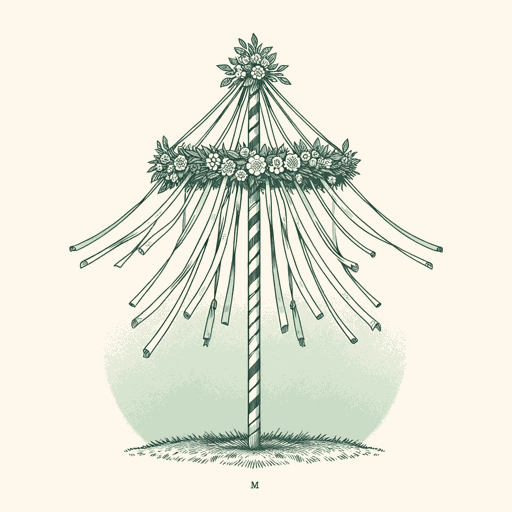
The Maypole Of Merry Mount
The Minister's Black Veil
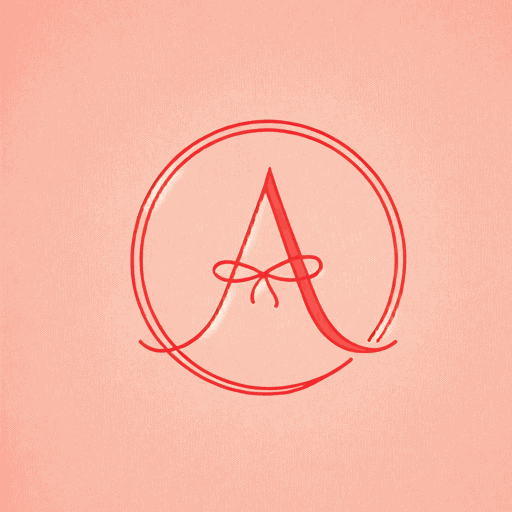
The Scarlet Letter

The Wives of the Dead
Young Goodman Brown
Featured Collections
View Collection
Nathaniel Hawthorne’s “The Birthmark” Short Story Essay
Introduction, the brief basic plot of the story, works cited.
During Nathaniel Hawthorne’s lifetime, there was a tremendous advancement in science and technology. People began believing that all of life’s unanswered questions would soon be answered in the laboratories of the scientists if they would just have the patience to wait long enough. It was felt that with just a little time, all the evils of society would be ironed out and all imperfections would be cured. These are the issues examined in Hawthorne’s short story “The Birthmark.”
The story is essentially the story of a scientific man who cannot stand a small birthmark visible on his wife’s cheek and which she agrees to attempt to remove in a process that eventually kills her. In this story, Hawthorne illustrates through the symbolism of the birthmark science’s approach toward ‘perfecting’ society, society’s acceptance of this approach and the true nature of this type of imperfection.
Hawthorne uses the symbol of the birthmark as a way of illustrating science’s approach to the aberrations of nature as a problem that needs to be fixed. Aylmer’s wife Georgiana has a tiny hand-shaped birthmark on her face that shows most clearly when she is pale and upset and tends not to show at all when she is happy and rosy. As Hawthorne points out, there were generally two approaches taken toward this small defect in her otherwise perfect face. “Georgiana’s lovers were wont to say that some fairy at her birth hour had laid her tiny hand upon the infant’s cheek, and left this impress there in token of the magic endowments that were to give her such sway over all hearts.”
On the other hand, “some fastidious persons – but they were exclusively of her own sex – affirmed that the bloody hand, as they chose to call it, quite destroyed the effect of Georgiana’s beauty, and rendered her countenance even hideous.” This was the approach taken by Aylmer to such a degree that his only consideration of it was to find a means of removing it, regardless of the dangers this process might present to his lovely wife’s ultimate health or future. Aylmer feels the wife of a scientist as prestigious as himself should be absolutely free of any perfections nature might have bestowed upon her. Because he is unable to accept her ‘imperfections’ as signs that she is a natural and very human woman, he is unable to enjoy the life of happiness the couple should have otherwise enjoyed.
It is through the actions of Georgiana that the attitudes of society toward science are reflected in this short story. When Aylmer first suggests that Georgiana could have the birthmark surgically removed, she is shocked and reluctant to even consider the possibilities. “To tell you the truth it has been so often called a charm that I was simple enough to imagine it might be so,” she tells him. However, his continued horror at the sight of the mark works on her spirit as does the continued calls of science, shocked and dismayed at the rest of society’s reluctance to experiment where it is perceived only God should go, work on society itself.
Finally, Georgiana gives in to Aylmer’s suggestion, passively agreeing to participate in whatever form of experiment he might choose to present to her and asking few, if any, questions as to what he’s been doing. “Georgiana began to conjecture that she was already subjected to certain physical influences, either breathed in with the fragrant air or taken with her food.” Finally, when she finally perceives the danger involved in the experiment, she confronts Aylmer with a desire for more knowledge, but when he refuses to give her any details, she readily agrees to do whatever is asked of her again.
Finally, Hawthorne illustrates that not all natural imperfection is necessarily something evil that must be cured by science as the fading of the birthmark results in the death of the lady. Its shape and the suggestion that it is the loving result of a fairy touch indicate that the birthmark has some sort of spiritual connection to the lady.
This is emphasized in Aylmer’s dream: “He had fancied himself with his servant Aminadab, attempting an operation for the removal of the birthmark; but the deeper went the knife, the deeper sank the hand, until at length its tiny grasp appeared to have caught hold of Georgiana’s heart; whence, however, her husband was inexorably resolved to cut or wrench it away.” This foreshadows the destructive task he has embraced as well as the purity and tenderness externally represented in the form of the mark.
The essential nature of the mark to the lady’s person is again brought forward when Aylmer finally comes partially clean to Georgiana, just before administering the final draught: “Know, then, that this crimson hand, superficial as it seems, has clutched its grasp into your being with a strength of which I had no previous conception. I have already administered agents powerful enough to do aught except to change your entire physical system.” When he does give her the drink to change her system, she is perfected and can no longer remain on earth in human form.
Through this short story, which sees very little in the way of actual action, Hawthorne is able to criticize the aims of science and to question its relative merits. Through the symbolism of the birthmark and its wearer, Hawthorne manages to illustrate how science remains fixated on fixing things that may not need to be fixed or that should be appreciated for their own intrinsic value. By focusing on the behavior of the wearer of the birthmark, and thus its guardian and protector, Hawthorne demonstrates the less than ideal reaction of the public toward the more outlandish scientific ideas as well as illustrates how the public is eventually won over to these ideas.
Finally, by showing his readers that the birthmark is valuable in protecting the life of this lady, that it is a necessary part of her humanity, Hawthorne indicates how science has the power to destroy something special and irreplaceable without bringing any benefit to mankind in its place.
Hawthorne, Nathaniel. “The Birthmark.”
- Chicago (A-D)
- Chicago (N-B)
IvyPanda. (2021, August 16). Nathaniel Hawthorne’s “The Birthmark” Short Story. https://ivypanda.com/essays/nathaniel-hawthornes-the-birthmark-short-story/
"Nathaniel Hawthorne’s “The Birthmark” Short Story." IvyPanda , 16 Aug. 2021, ivypanda.com/essays/nathaniel-hawthornes-the-birthmark-short-story/.
IvyPanda . (2021) 'Nathaniel Hawthorne’s “The Birthmark” Short Story'. 16 August.
IvyPanda . 2021. "Nathaniel Hawthorne’s “The Birthmark” Short Story." August 16, 2021. https://ivypanda.com/essays/nathaniel-hawthornes-the-birthmark-short-story/.
1. IvyPanda . "Nathaniel Hawthorne’s “The Birthmark” Short Story." August 16, 2021. https://ivypanda.com/essays/nathaniel-hawthornes-the-birthmark-short-story/.
Bibliography
IvyPanda . "Nathaniel Hawthorne’s “The Birthmark” Short Story." August 16, 2021. https://ivypanda.com/essays/nathaniel-hawthornes-the-birthmark-short-story/.
- Nathaniel Hawthorne: Original Sin in "The Birthmark"
- "The Birthmark and "The Minister's Black Veil" Compared
- "The Story of an Hour" and "The Birthmark"
- Hawthorne's "Rappacini's Daughter" and "The Birthmark": Comparison
- Positivism in “The Birth-Mark” by N. Hawthorne
- Arete, Phenomenalism, and Semantics in "The Birth-Mark"
- Perfection in Hawthorne’s “The Birthmark” and Bradbury’s “The Veldt”
- Symbols in The Birth-Mark by Nathaniel Hawthorne
- Aylmer's Obsession in "The Birth-Mark" by Nathaniel Hawthorne
- "Ethan Brand" and "The Birthmark" by N. Hawthorne
- Wouk's Marjorie Morningstar and Yates' Revolutionary Road
- Ernest Hemingway’s “The End of Something” Story
- Jack London's Martin Eden in the Context of American Realism
- "Trifles" by Susan Glaspell: Murder, She Wrote
- Poverty in Bambara's The Lesson and Danticat's A Wall of Fire Rising
Home — Essay Samples — Literature — Nathaniel Hawthorne — Literary Devices In The Birthmark: Analysis Of Symbolism
Literary Devices in The Birthmark: Analysis of Symbolism
- Categories: Nathaniel Hawthorne
About this sample

Words: 829 |
Published: Dec 16, 2021
Words: 829 | Pages: 2 | 5 min read
- Hawthorne, Nathaniel. 'The Birthmark.' Mosses from an Old Manse and Other Stories. 1846, edited by Charles Keller, Project Gutenberg, 2008.
Should follow an “upside down” triangle format, meaning, the writer should start off broad and introduce the text and author or topic being discussed, and then get more specific to the thesis statement.
Provides a foundational overview, outlining the historical context and introducing key information that will be further explored in the essay, setting the stage for the argument to follow.
Cornerstone of the essay, presenting the central argument that will be elaborated upon and supported with evidence and analysis throughout the rest of the paper.
The topic sentence serves as the main point or focus of a paragraph in an essay, summarizing the key idea that will be discussed in that paragraph.
The body of each paragraph builds an argument in support of the topic sentence, citing information from sources as evidence.
After each piece of evidence is provided, the author should explain HOW and WHY the evidence supports the claim.
Should follow a right side up triangle format, meaning, specifics should be mentioned first such as restating the thesis, and then get more broad about the topic at hand. Lastly, leave the reader with something to think about and ponder once they are done reading.

Cite this Essay
Let us write you an essay from scratch
- 450+ experts on 30 subjects ready to help
- Custom essay delivered in as few as 3 hours
Get high-quality help

Prof. Kifaru
Verified writer
- Expert in: Literature

+ 120 experts online
By clicking “Check Writers’ Offers”, you agree to our terms of service and privacy policy . We’ll occasionally send you promo and account related email
No need to pay just yet!
Related Essays
2.5 pages / 1033 words
1 pages / 381 words
3.5 pages / 1676 words
2 pages / 964 words
Remember! This is just a sample.
You can get your custom paper by one of our expert writers.
121 writers online
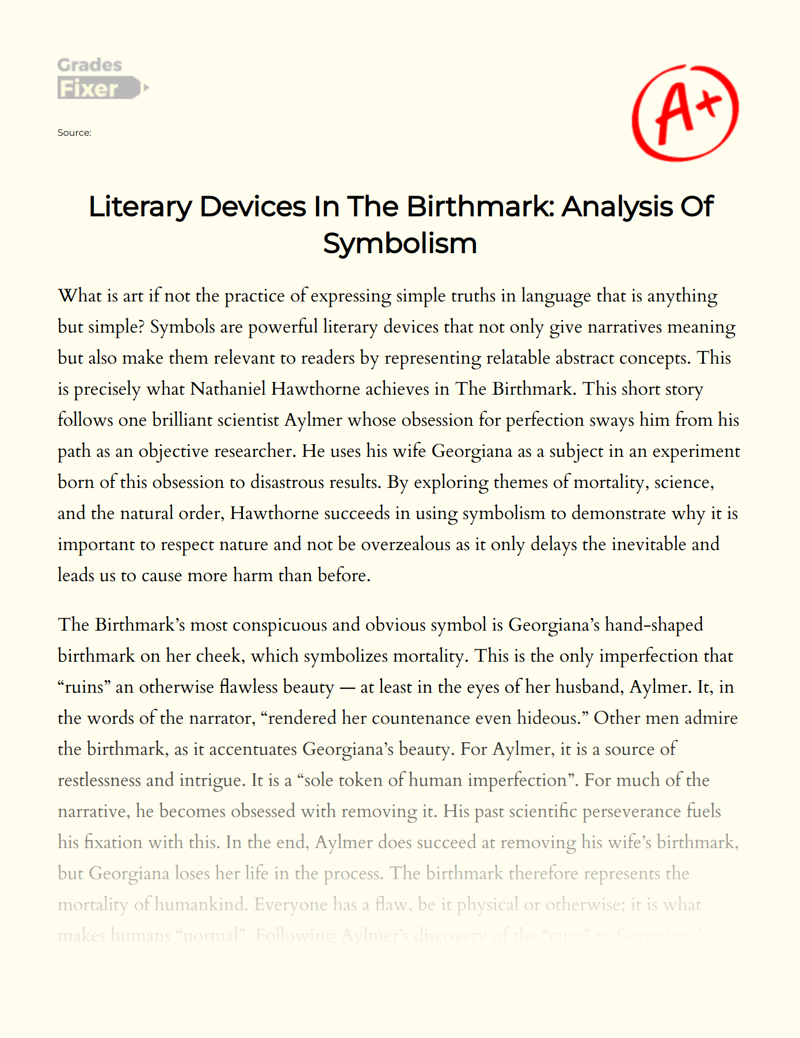
Still can’t find what you need?
Browse our vast selection of original essay samples, each expertly formatted and styled
Related Essays on Nathaniel Hawthorne
When a person or character makes a mistake or commits an affective act, their life can be altered both negatively and positively. This idea takes an important contribution in The Scarlet Letter by Nathaniel Hawthorne. This novel [...]
Nathaniel Hawthorne's novel, The Scarlet Letter, explores the theme of revenge through the character of Roger Chillingworth. Chillingworth's quest for vengeance against Arthur Dimmesdale, the town's minister, drives much of [...]
Nathaniel Hawthorne, one of the most renowned American authors of the 19th century, is best known for his novel The Scarlet Letter. This masterpiece delves into themes of sin, guilt, and redemption, drawing upon Hawthorne's [...]
Hester Prynne is considered to be both one of the first heroines and feminist icons in American Literature. This is despite Nathaniel Hawthorne, born on July 4, 1804 in Salem, Massachusetts, being labelled as a misogynist, [...]
The literature of the American Renaissance is rich in symbolism, and in no author's work is this more evident than in that of Nathaniel Hawthorne. Perhaps the most popular of his works, The Scarlet Letter has long been [...]
On the surface, Nathaniel Hawthorne’s "Dr. Heidegger’s Experiment" is a story about several troubled adults who are given the chance to go back to their youths and enjoy their former, more beautiful selves. The idea of youth in [...]
Related Topics
By clicking “Send”, you agree to our Terms of service and Privacy statement . We will occasionally send you account related emails.
Where do you want us to send this sample?
By clicking “Continue”, you agree to our terms of service and privacy policy.
Be careful. This essay is not unique
This essay was donated by a student and is likely to have been used and submitted before
Download this Sample
Free samples may contain mistakes and not unique parts
Sorry, we could not paraphrase this essay. Our professional writers can rewrite it and get you a unique paper.
Please check your inbox.
We can write you a custom essay that will follow your exact instructions and meet the deadlines. Let's fix your grades together!
Get Your Personalized Essay in 3 Hours or Less!
We use cookies to personalyze your web-site experience. By continuing we’ll assume you board with our cookie policy .
- Instructions Followed To The Letter
- Deadlines Met At Every Stage
- Unique And Plagiarism Free
The Birthmark Literary Analysis Essay Sample
Beauty in society is set as a standard by what is expected of someone to be more than what they already are. People cause harm to their bodys by trying to change how they look because they want to be liked by society. This is done by plastic surgery, editing enhancements, unhealthy eating habits, etc. The fiction short story “The birthmark” by Hawthorne accentuates this very harsh opinion of beauty through the character Alymer wanting to change his wife, Georgiana, by giving her a chemical solution to drink to take away the “hideous” birthmark. Hawthorne uses characters and setting to reveal a theme of obsessing over changing something that is already beautiful can lead to negative effects.
The characters of “The birthmark” by Hawthorne exhibit qualities that shape the story's theme of obsessing over changing something that is already beautiful can lead to negative effects. Alymer, the husband of Georgiana, is very obsessed with changing his already beautiful wife. People claim that she is so perfect and there was nothing wrong with her. Alymer has a manipulative and obsessive character shown by his thoughts throughout the story that contributes to the not so happy ending. Alymer has been so obsessed with removing the birthmark and he even begins to dream of doing it: “When the dream had shaped itself perfectly in his memory, Alymer sat in his wife's presence with a guilty feeling” (Hawthorne). Likewise he shows that he feels guilty but also is so compolussed to remove it that he even dreams about it. He goes into detail explaining how the negative effects ultimately leads her to die in the dream which shows some sort of foreshadowing of what really will happen. His negative thoughts about his beautiful wife are damaging her and causing her gloomy state. He has a sort of malicious intent without realizing it. She was extremely beautiful but not in the eyes of Alymer. The “imperfection”of Georgiana also causes their marriage to despair into thin air which is another negative effect of changing beauty. Hawthorne shows Almyers inner thoughts about Georgiana, “But, seeing her otherwise so perfect, he found this one defect growing more and more intolerable, with every moment of their united lives” (Hawthorne). He grew so fixated on one thing that it ultimately hurt themselves rather than just choosing to ignore a minor thing. His character very obviously shows that he likes to control things but when he can not even control his experiments the only thing left is his wife. Almyer and Georgiana are a very exaggerated example of what can happen to two people. Ultimately, a failed marriage and death were the result of obsessing over changing something that is already beautiful which leads to becoming negative.
The Lab and Garden of “The birthmark” by Hawthrone that continue the obsessive tone contributing to the story's theme of obsessing over changing something that is already beautiful can lead to negative effects. The short story takes place in a cold ominous lab and no light is ever let in. The reason the light is never left is because that is a part of nature. This exemplifies his love and devotion to science but hate for nature's power. As the home of Alymer and Georgiana is being pictured it also shows the seclusion they really do live in: “They were to seclude themselves in the extensive apartments occupied by Alymer as a laboratory, and where, during his toilsome youth, he has made some discoveries in the elemental powers by Nature…” (Hawthorne). They built their own little part of the world for themselves to help Almyer better understand the world even though his experiments never went well. When he can not fix his wife's birthmark he knows it is the one thing he couldn't fix or understand out of all of his experiments. Alymer can be seen as being too critical of things in his life. Georgiana finds the logs of his experiments and Alymer catches her: “So deeply did these reflections affect Georgiana, that she laid her face upon the open volume and burst into tears. In this situation she is found by her husband.” (Hawthorne). As his wife is going into his lab she discovers his books logging his experiments in the past. Furthermore,what she discovers is shocking… he never really discovered the experiments but his failed ones turn into a different result than what he expects.. Georgiana expresses her fearful tone and wonders what will happen to her. Aylmer manipulates Georgiana but she thought she has to be better for him. In some ways she could be compared to the garden and the light not allowed into the lab because of her beauty. This could possibly be why she is never allowed in the lab unless she is getting tested on. In the end, the experiment, the lab and garden were a symbol of the true meaning that obsessing over changing something that is already beautiful can lead to negative effects.
Light can be considered a beauty in creating rainbows, happiness, positivity, etc. which could be intended to be a symbol of “The birthmark” by Hawthorne. The tone of the short story can be perceived as morose. The theme is epitomized by Almyer the cat wanting the mouse in a tiny hole of a house. The characteristics exhibited by Almyer were disdainful and made him not a likable character which concludes to the negative theme. The laboratory and garden were key figures in developing the story that leads to the climax. Therefore the theme can be proven to be true. The author's intent is to show obsessing over a topic can lead to negative outcomes no matter how little or serious. In final thought, the use of obsessing over changing something that is already beautiful can lead to negative effects is exemplified throughout the short story “The birthmark” by Hawthorne through characters and setting.
Related Samples
- The Importance Of Freedom In The Giver Essay Example
- Ralph in Lord of the Flies Essay Example
- Setting Of The Great Gatsby Essay Example
- Thesis Statement Example: Humanity in Mary Shelley's Frankenstein
- Their Eyes Were Watching God by Zora Neale Hurston Analysis
- Night by Elie Wiesel Religion Essay Example
- Adversity in to Kill a Mockingbird Essay Sample
- Prejudice Theme in To Kill a Mockingbird
- Justice for George in Of Mice and Men Essay Example
- Piecing Me Together by Renee Watson Book Analysis Essay Example
Didn't find the perfect sample?

You can order a custom paper by our expert writers

Essay Resources
- Research Papers
- Term Papers
- Book Report
- Movie Review
- Article Critique
- Annotated Bibliography
- PowerPoint Presentations
- Testimonial
Sample Essay
Critical Analysis Essay of The Birthmark
The Birthmark is short story written by the American novelist Nathaniel Hawthorne. It follows the story of Aylmer and his obsession of removing the birthmark of his beautiful wife Georgina. His unnatural fixation to his wife’s birthmark even consumes him in his sleep as he dreams of cutting it off much like scraping an apple off its skin (Snodgrass 29). Within the narrative, the author explores two important themes. This includes the unattainability of perfection along with the opposing poles of science and the natural world.
One of the major themes presented in this story is perfection which was exemplified by Aylmer. More particularly, the main character was obsessed with the idea of making his wife perfect by removing the birthmark off her cheeks. Georgina was already a beautiful woman. In fact, many men would risk their life in order to kiss her birthmark. Aylmer on the hand, believes that this mark on his wife’s skin is but a flaw that should be erased. This explains irrational obsession continues to follow him in his dreams. And even in his waking hours, all that he can see is his wife’s imperfection. This desire for fixation however, will never be possible. Even Hawthorne suggests that the concept of perfection is something that does not exist on earth. Georgina herself also understands this. She knows that the birthmark is but a superficial indication of her wife’s impossible quest for perfection. This is best exemplified in the passage:
“With her whole spirit she prayed that, for a single moment, she might satisfy his highest and deepest conception. Longer than one moment she well knew it could not be; for his spirit was ever on the march, ever ascending… requiring something that was beyond the scope of the instant before” (Hawthorne 34).
This quote only shows Aylmer’s deep insanity and madness that comes from his quest for perfection. Georgina realizes that even if she managed to give him this demand, her triumph would be but short lived. This is simply because after that, he would still be demanding for more. In the end, Aylmer’s deranged wish to rid of the birthmark caused Georgina her life.
Another important theme in the story is the opposing poles of nature and science. In fact, this is a story that is touched by wild scientific experiment which was conducted by Aylmer. Hence, science in this story is represented by Aylmer, whereas nature is mirrored by the character of Georgina. As a scientist, Aylmer tries his best to create a powerful medicine or portion which could rid of Georgina’s flaw or birthmark. But what is more interesting about this piece is that despite the powerful potion which he asked his wife to drink in order to remove the birthmark, the power of nature still prevails in the end. Georgia exemplifies the power of nature over science as her birthmark captivates almost everyone who looks at it. Aylmer on the other hand, because of his desire to control nature results in the death of his wife (Sterling 167).
Based on the points provided, it can be argued that Hawthorne, in this story, used the powerful themes of perfection as well as science and nature. Perfection in this story is exemplified by Aylmer and his deep desire to make his wife even more perfect by removing her birthmark. Alternately, the themes of science versus nature are demonstrated by the relationship and the characters of Aylmer and Georgina. Aylmer mirrors the power of science which desires to control nature; while Georgina symbolizes nature which triumphs over science at the end of the story.
Works Cited
Hawthorne, N. The Birthmark. NY: Perfection Learning Corporation, 2007
Snodgrass, M. Gothic Literature. NY: Infobase Publishing, 2009
Sterling, L. Bloom’s How to Write about Nathaniel Hawthorne. NY: Infobase Publishing, 2009
Our Services
Testimonials, essayresources.com, literary analysis essay of william shakespeare’s ‘titus andronicus’, literary analysis essay of alfred lord tennyson’s ‘in memoriam’, get some social.

Nathaniel hawthorne, everything you need for every book you read..

Analysis. In the late eighteenth century, a great scientist named Aylmer takes a break from his experiments to marry a beautiful woman named Georgiana. It is a time of many great scientific discoveries, and scientists feel that they're uncovering all of nature's mysteries and might soon even be able to create life.
In seeking to destroy one unwanted detail, he unwittingly destroys all of the things around it which he loved and treasured. By Dr Oliver Tearle (Loughborough University) 'The Birthmark' is a short story by the nineteenth-century American writer Nathaniel Hawthorne, first published in 1843. Although not as well-known as 'Young Goodman ...
Thus, we can say that "The Birthmark" expresses a very profound meaning; men make an effort to change nature in order to make it more flawless than it already is. Even though "The Birthmark" by Nathaniel Hawthorne was written in the mid-1800s, its subject and ideas still play a part in today's society. "In the late eighteenth century ...
Overview. "The Birthmark" is a short story by American author Nathaniel Hawthorne, first published in 1843. The story revolves around Aylmer, a scientist, and his beautiful wife Georgiana, whose only flaw is a small birthmark on her cheek. Aylmer becomes consumed by the desire to remove the birthmark, believing it symbolizes imperfection ...
Hawthorne's short story "Rappaccini's Daughter," published along with "The Birthmark" in the collection Mosses from an Old Manse, tells the story of a scientist's daughter who cares for his poisonous plants and becomes poisonous herself. When a man falls in love with her and tries to give her an antidote to the poison, she dies.
Analysis: "The Birthmark". "The Birthmark" was published during a time of change and innovation in British and American literature. While gothic fiction was still in existence in the 1840s, new elements characteristic of the genre now called "science fiction" or "speculative fiction" were creeping into literature during this age ...
Summary: "The Birthmark". "The Birthmark" by Nathaniel Hawthorne (1804-1864) was initially published in the March 1843 edition of The Pioneer, a short-lived literary periodical which was also the first to showcase Edgar Allan Poe's famous "The Tell-Tale Heart." "The Birthmark" was later serialized in Mosses From An Old Manse ...
The brief basic plot of the story. Hawthorne uses the symbol of the birthmark as a way of illustrating science's approach to the aberrations of nature as a problem that needs to be fixed. Aylmer's wife Georgiana has a tiny hand-shaped birthmark on her face that shows most clearly when she is pale and upset and tends not to show at all when ...
The Birthmark By Nathaniel Hawthorne. "The Birthmark" is a short story authored by Nathaniel Hawthorne and published in 1848. The story is about Aylmer, a brilliant scientist who is obsessed with science and is planning to use his experiments to remove a birthmark on the face of his wife Georgiana.
College of Foreign Languages and Cultures, Sichuan University, Chengdu, China. Abstract: "The Birthmark" is a short science fiction created by Nathaniel Hawthorne in 1843. The story tells of an eighteenth-century scientist who attempts to remove his wife's birthmark yet takes her life in the end. This paper will use Louis Montrose's ...
Get original essay. Topic sentence: The Birthmark's most conspicuous and obvious symbol is Georgiana's hand-shaped birthmark on her cheek, which symbolizes mortality. This is the only imperfection that "ruins" an otherwise flawless beauty — at least in the eyes of her husband, Aylmer.
The Birthmark Literary Analysis Essay Sample. Beauty in society is set as a standard by what is expected of someone to be more than what they already are. People cause harm to their bodys by trying to change how they look because they want to be liked by society. This is done by plastic surgery, editing enhancements, unhealthy eating habits, etc.
See key examples and analysis of the literary devices Nathaniel Hawthorne uses in The Birthmark, along with the quotes, themes, symbols, and characters related to each device. Allegory 1 key example. Allusions 1 key example. Foreshadowing 1 key example.
Although "The Birthmark" by Nathaniel Hawthorne was written in the mid-1800s, its themes and ideas are still a part of society today. The 19th century was a time of change, just as this, the millennium, is a time of great change. Hawthorne's ideas about science, beauty, and life still play a major part in our lives, despite many improvements.
In Nathaniel Hawthorne's short story "The Birthmark," there are many views on the need for science and its advances. Hawthorne's protagonist, Aylmer, illustrates his own personal assessment of science. The story is based on the idea that science can solve all of humanities ills and problems. Hawthorne believes that science is overrunning life.
Explanation and Analysis—The Birthmark: The birthmark is another example of personification. Not only is it shaped like a human hand, it is also described as threatening Georgiana's life. In the first part of the story, Aylmer dreams about the birthmark's deadliness: Its tiny grasp appeared to have caught hold of Georgiana's heart.
The Birthmark Literary Analysis Essay. 717 Words3 Pages. Here is a story of Aylmer, "a man of science," who had a wife who was known for her beauty and her "hand-shaped birthmark.". Although perfect in the eyes of her admirers, her husband did not agree for the birthmark grew more and more intolerable for him in their lives together.
Literary Analysis Of The Birthmark. Written by Nathaniel Hawthorne during the American Renaissance, the short story "The Birth-Mark" details the events of a brilliant scientist and natural philosopher named Aylmer who obsesses about his wife Georgiana's birthmark in the shape of a tiny hand on her left cheek. The symbol of the birthmark ...
Jessica Johnson. Dr. DeFee. English 212-006. March 15, 2013. Literary Analysis of "The Birthmark" Romanticism is the keen sense of life of the natural person. It was a cultural movement from 1770 to 1860. This movement established nature as the beginning and the end. A notable writer of the Romanticism era was Nathaniel Hawthorne. One of ...
The Birthmark Literary Analysis For instance, when Aylmer felt miserable, she felt miserable too. Nevertheless, it can be seen that then she demonstrated a total opposite attitude, a strong woman who challenges his husband to go ahead with his experiments.
The Birthmark is short story written by the American novelist Nathaniel Hawthorne. It follows the story of Aylmer and his obsession of removing the birthmark of his beautiful wife Georgina. His unnatural fixation to his wife's birthmark even consumes him in his sleep as he dreams of cutting it off much like scraping an apple off its skin ...
Aminadab. Aminadab is Aylmer 's laboratory assistant. He is a grotesque character—physically strong, ugly, and "earthy.". He does not understand any of the science behind Aylmer's experiments, but ably executes whatever tasks Aylmer sets him. Aminadab… read analysis of Aminadab. Previous.

IMAGES
VIDEO
COMMENTS
Whether you're just starting out or already have some experience, we offer various Presentation Skills courses designed to fit your needs. Curated from top educational institutions and industry leaders, our selection of Presentation Skills courses aims to provide quality training for everyone—from individual learners seeking personal growth to corporate teams looking to upskill.
Top Tips for Creating an Effective Training Presentation. What we commonly call "effective presentation" is the right balance of two elements: the content you provide and how you deliver it. The first part is on your expertise and every piece of information you can share. But the second part is where the real magic happens.
7 hours. Best PowerPoint Animated Videos Course (Udemy) 4-5 hours. Best Presentation Design Course for Business (LinkedIn Learning) 1-2 hours. Best Microsoft 365 - PowerPoint Crash Course (LinkedIn Learning) 1-2 hours. Also Great: Effective Business Presentations with PowerPoint (PwC) 11 hours.
Tip #3: Keep your slides short and sweet. Tip #4: Focus on your presentation design. Tip #5: Visualize boring numbers and data. Tip #6: Practice in front of a live audience. Tip #7: Meet your audience before presenting. Tip #8: Channel nervous energy into enthusiastic energy.
21 Get crafty (ripped paper details) Sometimes to tell a story, visual details can really help get a mood across. Ripped paper shapes and edges can give a presentation a special feel, almost as if it was done by hand. This visual technique works for any type of presentation except maybe in a corporate setting.
1 Use games and activities. One way to make presentation skills training more fun and engaging is to use games and activities that challenge and stimulate your participants. Games and activities ...
1 Assignment. Choose Your Presentation—Choose the 10-15 minute presentation you'll be workshopping throughout the course. Use an existing presentation or choose from one of our sample presentation prompts. Identify your audience, your starting assumptions for what you must do or include in this presentation, and the skills you most want to ...
Here are five compelling reasons to invest in executive presentation training: Enhanced Presentation Skills: Our training polishes your ability to design striking slides, narrate compelling stories, and deliver with a clear, confident voice. Masterful Storytelling: Learn the techniques to weave stories that engage, captivate, and drive your ...
Here are a few tips for business professionals who want to move from being good speakers to great ones: be concise (the fewer words, the better); never use bullet points (photos and images paired ...
One example could be a presentation covering "The Best Free Alternatives to Microsoft Office.". Memoir: Tell the stories of influential people or your own in a value-packed presentation. Video Games: You can reveal the pros and cons of a game or just talk about the trendiest games as of now.
On Chromecast, choose to use the split screen. One side shows the video of you teaching, and the other is the training presentation you prepared. Send the recording to the employees that didn't attend in person or live online. Infographic of the steps required to create a SCRUM training presentation. 3.
How to illustrate presentation structure and content types on a slide. Visualizing speaker and listener types. Presenting various meeting room setups. How to show hints for preparing speech and presentation itself. Closing the presentation training with a recap and summary slide. Whether you are a professional communication trainer or a ...
1. Prezi. Prezi is renowned for its dynamic and non-linear presentation style, enabling users to craft visually stunning and interactive presentations. With an array of templates and animation effects, Prezi enhances audience engagement, making your presentations more captivating and memorable. 2.
Lloyd Harbor, NY 11743. [email protected]. 1.800.509.6599. Presentation Training, creative presentation training, management training and pitch consulting are the four cornerstones that Filament helps advertising agencies build through custom designed programs.
15 Training Presentation Topics to Upskill Your Team. Constant training offers numerous benefits to the business such as improved employee advocacy, increased team productivity, and job satisfaction - just to name a few. So, go beyond the traditional onboarding and get ready to upskill your team all year long.
Canva is an easy-to-use alternative to PowerPoint. This presentation without PowerPoint software comes with templates ready to use. You'll have access to millions of images if you use the paid plan. This free software comes with premium features you can get with the Canva Pro Plan is USD 119.99 per year per person.
creative presentation names; sample article 78 notice of petition; nrich problem solving activities; algorithm for problem solving in computer; the hardest math problem to solve; how to solve sales tax word problems; new york university mfa creative writing application; recommended books nonfiction; case study technology in education
Mission and Vision. Mission. First successful projects, then lasting relationships! As it has been in the past 40 years, Mimsa believe in providing competitive prices without compromising their principles of quality. We have managed to create lasting relationships based on honesty and cooperation while adding new customers each year.
Catalysis Conference is a networking event covering all topics in catalysis, chemistry, chemical engineering and technology during October 19-21, 2017 in Las Vegas, USA. Well noted as well attended meeting among all other annual catalysis conferences 2018, chemical engineering conferences 2018 and chemistry webinars.
presentation designer jobs in London. Sort by: relevance - date. 820 jobs. Compliance Engineer. BSRIA Ltd. North London. £33,000 a year. Full-time +1. 8 hour shift +2. Driving Licence. Compliance: 1 year. United Kingdom. Easily apply: Responsive employer. Liaising with, and presentation of findings to clients and site management.... Today's top 178 Presentation Designer jobs in London ...